Katherine Langrish's Blog, page 11
October 13, 2020
Goddesses, Queens and Witch-Queens
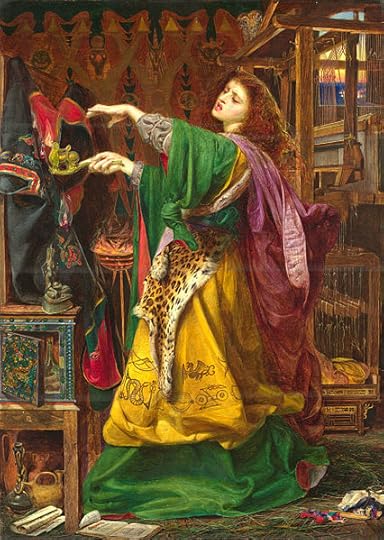
Here we are in October with Hallowe'en coming up in only a couple of weeks, and it seems a good time to write a post about witches. (In fact, maybe two posts. Maybe three.)
‘Witch’ is not a neutral word. There can be good wizards or bad wizards, it seems, so that when you encounter a fictional wizard you cannot be certain at first which way he leans. Gandalf is good, Saruman was good once and then turned out to be bad. But the default option for any fictional witch is wickedness unless qualifying adjectives are used, such as ‘white’ (or possibly 'hedge'). Why? After all, wizards and witches both use magic, so why the gender-based difference? In later posts I want to consider some of the many witches who appear in children’s literature. But there’s some interesting background to cover first.
Off the top of my head, the earliest witch I can think of is the Witch of En-dor in the Hebrew Bible (1 Samuel 28: you see her, pictured below). In fact the Bible never describes her as a witch, but the inference down the centuries has been that since she has a familiar spirit and can communicate with the dead, that’s what she must be. Nowadays she'd probably be called a medium, but the column header of my 1810 Bible states quite definitely: ‘Saul confulteth a witch’. In spite of having banished from the land all who have trafficked with ghosts and spirits, King Saul – desperate because he's got a Philistine army mustering on his borders and God is ignoring him – visits the woman secretly in disguise and asks her to call up the spirit of the prophet Samuel, whom he hopes will give him counsel. (Imagine if Aragorn had tried to summon up the ghost of Gandalf after his plunge into the abyss – it might not have been the best plan.) With extreme reluctance, the woman obliges, and though it’s not clear from the Bible account if Saul ever sees Samuel at all, the woman does: she describes him rising from the earth ‘like an old man coming up, wrapped in a cloak’. Of course it ends in disaster for Saul, as the displeased Samuel foretells his death.

The narrative is critical of Saul’s hypocrisy in banning consultations with the dead and then employing them himself, but it’s hard not to feel some sympathy with the hard-pressed king. It’s a time of bloody conflict: Samuel informs Saul that one reason the Lord has ‘torn the kingdom from your hand and given it to … David’ is that Saul has ‘not obeyed the Lord or executed his judgement on the Amalekites’. For which read: hasn't massacred them. But the Bible account isn't especially critical of the woman herself. While Saul collapses in terror at Samuel’s words, she first scolds him – ‘I listened to what you said and I risked my life to obey you’ – and then cooks him a much-needed meal. Saul has put her in an awkward position, and she did what he asked, that’s all. She really doesn't deserve to go down in history as a wicked witch.
Then why in popular culture, are witches nearly always women? To put it another way, why has women’s wisdom over the past couple of millennia so often been distrusted as likely to be ungodly in origin and therefore evil? In one sense it’s obvious: by their nature polytheisms may be (they aren’t always) relaxed about other gods, able to welcome or absorb them. But a monotheistic religion, if it is to remain so, must insist that rival gods are evil or null. The Christian martyrs suffered because of a head-on collision between a system that was uninterested in private faith but required a public gesture of submission to the Roman State by a sacrifice to its gods, especially the reigning emperor – and a system that absolutely forbade submission to any but One.
And monotheisms seem to centre on gods, male gods. There seems no special reason why there couldn't be a monotheistic religion centred on a goddess but I'm not aware that such a thing has ever existed. Of course, to say that God is male or female makes no sense if he/she/they is pure spirit, but people naturally anthropomorphise. An inscription dated circa 800 BCE found on a large storage jar in north-east Sinai reads in part: ‘May you be blessed by Yahweh and his Asherah’, while another at a site a few miles from Hebron reads: ‘Uriah the rich has caused it to be written: Blessed be Uriah by Yahweh and his Asherah: from his enemies he has saved him.’ This, says Rafael Patai in his book The Hebrew Goddess , suggests with other evidence that ‘the worship of [the goddess] Asherah as the consort of Yahweh … was an integral element of religious life in ancient Israel prior to the reforms introduced by King Josiah in 621 BCE.’
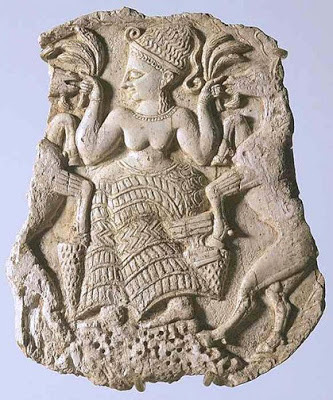 Ivory box-lid depicting Asherah
Ivory box-lid depicting Asherah representing the Tree of Life feeding a pair of goats. Though a God who could be symbolically addressed as King, Lord of Hosts, Master of the Universe and so on may have been a good fit for a patriarchal, warlike Iron Age society, Asherah was very important too. Patai explains:
"For about six centuries [after the arrival of the Israelite tribes in Canaan]; that is to say, down to the destruction of Jerusalem by Nebuchadnezzar in 586 BCE, the Hebrews worshipped Asherah (and next to her also other, originally Canaanite gods and goddesses) in most places and most times. Only intermittently, although with gradually increasing intensity and frequency, did the prophetic demand for the worship of Yahweh as the one and only god make itself be heard and was heeded by the people and their leaders." Asherah, who is named many times in the Bible, was the top Canaanite mother-goddess right back to the 14thcentury BCE. As ‘Lady Asherah of the Sea’ or simply Elath (‘goddess’) her husband was the chief god El (‘god’) who ruled the sky, Baal (‘lord’) was their son, and the war-goddess Anat was their daughter. Asherah’s worship in the form of a cultic image, a pole or pillar, was introduced into the temple by Rehoboam circa 928 BCE: in following centuries such pillars, set up in hilltop shrines, were being destroyed by reforming Yahwistic kings like Hezekiah and Josiah. Despite these struggles her cult and that of her daughter Anat/Astarte remained popular right down to the fall of Jerusalem and the destruction of the Temple in 586 BCE. When the prophet Jeremiah told the people that the calamity of the Exile had been Yahweh’s punishment for their wicked idolatry, they rejected it. In fact they claimed it was the other way around, that their troubles were all due to having neglected the goddess who used to care for them.
"We will not listen to what you tell us … We will burn incense to the Queen of Heaven and pour libations to her as we used to do, we, our fathers, our kings and our princes, in the cities of Judah and the streets of Jerusalem. For then we had plenty of food and were content; no calamity touched us. But since we stopped burning incense and pouring libations to her, we have been in great want and have fallen victim to sword and famine. And the women said, ‘It was not we alone who burned incense to the Queen of Heaven, and poured libations to her. Our husbands knew very well that we were making cakes marked with her image, and pouring libations to her.’ " [Jeremiah, 44, 15-19] It must have been troubling to give up (and risk offending) such a powerful protector. Asherah was the home-town goddess worshipped by the princess of Sidon, Jezebel, daughter of the ruler of the Phoenician empire, who married the Israelite king Ahab (873-852 BCE). It was usual for princesses marrying abroad to retain their own religious customs, so Ahab made a shrine for Jezebel where she could worship Baal and Asherah. This went down badly with the Yahwist prophet Elijah and his supporters, and Jezebel wasn’t the conciliatory sort. A religious tit-for-tat ensued, in which both sides destroyed the others' shrines and slaughtered their priests. It couldn't end well.
How much of this really happened is debatable: the scholar and archeologist Israel Finkelsteinwrites that the Biblical narrative of Jezebel and Ahab contains so many inconsistencies and anachronisms that it should be regarded as ‘more of a historical novel than an accurate historical chronicle’. But I’ve always liked Jezebel's courage and style as she defies her last enemy Jehu – frankly a thug: a king’s officer whom Elijah’s protegée and successor Elisha hand-picked to kill the king and take his place. Ahab is dead by now, and the new king is Jezebel’s son-in-law Jehoram. Seeing Jehu driving furiously towards the city of Jezreel in his chariot, Jehoram sends out messengers to enquire his purpose; when Jehu ignores them, he comes out to meet him himself. ‘Is it peace, Jehu?’ he optimistically enquires. Jehu responds, ‘Do you call it peace when your mother Jezebel keeps up her obscene idol-worship and monstrous sorceries?’ As Jehoram wheels around to flee, Jehu bends his bow and shoots him in the back.
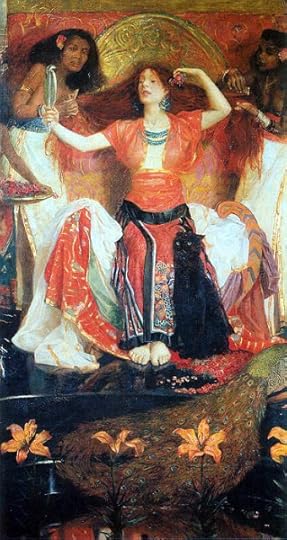
Hearing this news, Jezebel must have known she was a dead woman. She reacts like Shakespeare’s Cleopatra (‘Give me my robe, put on my crown. I have/Immortal longings in me…’) as with her hair dressed and her eyes painted, she stands royally visible in the window of the palace, looking down. As Jehu enters the gate below her, she calls a deliberately provocative challenge: ‘Is it peace, you Zimri, you murderer of your master?’ Zimri was a chariot commander who decades before had murdered his lord King Elah of Judah, after which he lived only seven days. For her to use his name as an insult suggests his treachery had become a byword: to call someone ‘Zimri’ may have been very like calling them ‘Judas’ now.
Jehu looked up at the window and said, ‘Who is on my side, who?’ Two or three eunuchs looked out, and he said, ‘Throw her down.’ They threw her down, and some of her blood splashed on the wall and the horses, who trampled her underfoot. Then he went in and ate and drank. ‘See to this accursed woman,’ he said, ‘and bury her, for she is a king’s daughter.’ But when they went to bury her they found nothing of her but the skull, the feet, and the palms of the hands.
Jehu claims that Jezebel's end fulfills Elijah’s prophecy that dogs would devour her and no one would be able to say where she was buried. Maybe so, but her splendidly arrogant defiance lives on. She was certainly no angel – the story says she ordered Naboth’s murder so that her husband Ahab could take his vineyard – but it hardly compares with the violence and cruelty of Jehu who continues his service to Yahweh by having all seventy princes of the house of Ahab slain and their heads piled in two heaps on either side of the city gate. He follows this deed with yet more massacres, and is praised by Yahweh for doing well. Then as now, atrocities are only committed by the other side.
Queen Jezebel was not a witch queen, but she might as well have been one. Her name is now practically synonymous with a wicked, glamorous, dangerous woman. What is a witch queen but a stereotype of feared and disapproved-of female power? The violence of Jezebel's death, along with the contempt and hatred which Jehu expresses towards her, testifies to the violence of feeling among Yahweh’s extremist followers: the effects of that far-off struggle persist to this day. Calling a woman a witch is never complimentary, but neither is it entirely without positive implications. A witch is a woman whose enemies perceive her as (illicitly) powerful, inspiring their fear and envy. A witch is a woman who cannot be ignored.
Next time: Witch Queens and Women's Power in YA & children's literature.
Picture credits:
Morgan le Fay - by Frederick Sandys, 1864 The Witch of Endor (detail from "The Endorian Sorceress Invokes the Shade of Samuel") by Dmitry Nikiforovich Martynov, 1857Ivory box-lid found at Ugarit (1300 BCE) depicting Asherah representing the Tree of Life, feeding a pair of goats.Jezebel - by John Liston Byam Shaw (1872 - 1919)
Published on October 13, 2020 05:36
October 6, 2020
Envoi to Strong Heroines: MAID MALEEN, a study of endurance through trauma
This essay was originally published in the 12th issue of Gramarye, Winter 2017
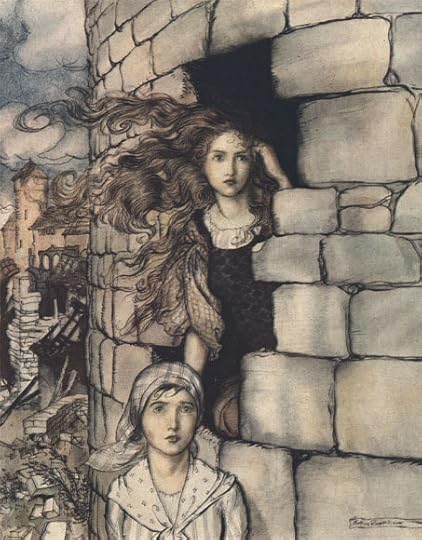
To round off my series of thirty fairytales which feature strong heroines, I'd like to repost an essay I wrote a couple of years ago about a fairy tale heroine whom many might not consider strong. For how can a girl who spends seven years imprisoned in a dark tower be an example of strength? Especially one who then seems to sink into a dark pit of post-traumatic depression? I argue that she is indeed an example of strength, and that our culture's focus on the kind of physical courage expressed in fighting and action leads us to forget or underestimate other forms of bravery. There isn't very much fighting in fairy tales! Often what they celebrate is the mental and spiritual courage all of us need to persist, endure, carry on in the face of pain, hardship, rejection, persecution. And this form of courage is often the courage of women. You can read Maid Maleen in full at this link, but I paraphrase it below. Though included in the Grimms' fairy tales (KHM 198), it's never been popular. It was first published as Jungfer MaleenSeven lang years I served for thee The glassy hill I clamb for theeThe bluidy shirt I wrang for theeAnd wilt thou no wauken and turn to me?
The time passed by, and by the decline of food and drink they knew that the seven years were coming to an end. They thought the moment of their deliverance was come; but no stroke of the hammer was heard, no stone fell out of the wall. All that prisoner-passivity and patience turns out to have been useless. The two women now seek actively to escape. They could have done so at any time before, but the weight of the king’s sentence, and their belief in it, lay upon them. Here Müllenhoff, emphasing the girls’ self-reliance, writes, ‘So they had to help themselves.’ (‘So mussten sie sich denn selber helfen.’) In the Grimms’ version Maid Maleen takes charge of their destiny but her words hint at the desperation she feels: ‘Maid Maleen said, “We must try our last chance, and see if we can break through the wall.”’ (‘Da sprach die Jungfrau Maleen: “Wir müssen das letzte versuchen und sehen, ob wir die Mauer dürchbrechen.”) Taking turns with a bread knife Maid Maleen and her maid scrape away the mortar between the stones and after three days of ‘great labour’ they push out a block and break through. Light rushes in. At last they can see the sky and breathe fresh air, but a new shock awaits: Her father’s castle lay in ruins, the town and villages were, so far as could be seen, destroyed by fire, the fields far and wide laid to waste, and no human being was visible.
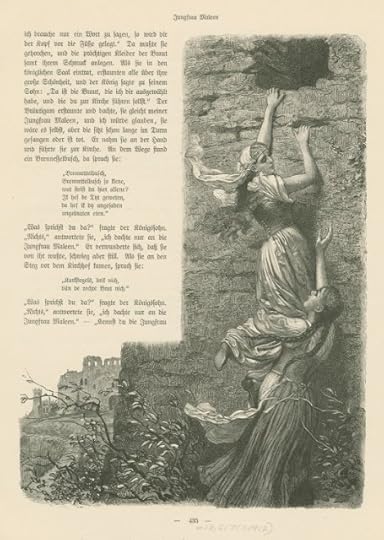
At this point Müllenhof repeats the purposeful phrase, ‘So they had to help themselves.’ In the Grimms’ tale the crushing effect of the discovery is conveyed by a rhetorical question, ‘But where were they to go?’ (‘Aber wo wollten sie sich hinwenden?’) During their imprisonment the world has changed. Huge events have taken place, of which they in their isolation were completely unaware. How is a prisoner to adjust, adapt? New-born into this empty, post-apocalyptic land, their hard-won freedom brings no joy. They can only wander, starving, living on handfuls of nettles, till they cross the border into a country ruled by that very King whose son was Maid Maleen’s lover. And he is about to marry another woman. At this point in other ‘lost bridegroom’ tales there is a sense of great purpose: the girl’s arrival at the place where her lover resides is the pinnacle of her journey, and she is full of determination to win him back. By contrast Maid Maleen’s wanderings have been aimless. She’s not aspiring to find and marry her sweetheart, she’s simply trying to survive. Even when she finds work as a kitchenmaid in the palace and is employed in carrying meals to the chamber of the royal-bride-to-be, she seems stunned, passive, futureless. When forced under threat of death to impersonate the false bride, she suffers it as another indignity rather than seizing the opportunity to reveal herself to the prince. Nothing could be further from the confident resolve of the heroine of The Black Bull of Norroway, or the mutually beneficial alliance of the two brides in The Girl Clad in Mouse-Skin. Significantly at this point, as if to emphasise Maid Maleen’s degradation, her own maid disappears from the story. Maid Maleen is the servant now. And so on her way to the church, dressed as the princess she used to be and holding her true love’s hand, Maid Maleen sees a nettle growing by the wayside and it triggers a crisis. I once ate nettles raw. Can I really be Maid Maleen? Who am I? ‘Do you know Maid Maleen?’ the prince asks eagerly as she murmurs the name. And she denies it. ‘No, how should I know her? I have only heard of her.’ Is she testing him? Is this a secret reproach? I don’t think so. Maid Maleen has been a princess, a prisoner and a beggar. Her father forgot her. Her lover forgot her. The world forgot her. Now she is a kitchen-maid impersonating a princess, a pretender and cheat. ‘I am not the true bride,’ she repeats, afraid that the honest world will reject her, the foot-bridge break under her step, the church door split as she passes through. ‘I am not the true bride.’ In no other fairy tale I know of does this rejection of self occur. Maid Maleen is the true bride, but dispossessed, traumatised, damaged. There is a poignancy in her behaviour which I find deeply moving. The world has broken under her and she cannot trust it, cannot trust herself. Her loss of identity is such that she will do nothing to reinstate herself, will not speak another word. It is up to the prince to put the false bride to the test as, unable to answer his questions, she tacitly admits her deceit: I must go out unto my maid Who keeps my thoughts for me. Should we feel sorry for the ugly bride? That would be a very modern reaction. Fairy tales operate by particular rules. Youthful beauty almost always signifies goodness, ugliness its opposite: what you see is what you get. Nevertheless Heather Robbins, to whom I owe the translation of Jungfer Maleen, has made the interesting point that unlike, say, the troll bride of The Black Bull of Norroway, this particular false bride knows she is ugly, and that when she repeats Maid Maleen’s words to the prince, she is being forced to utter the truth about herself: ‘I am not the true bride’. Is it an elaborate trap? Can Maid Maleen be deliberately tricking her?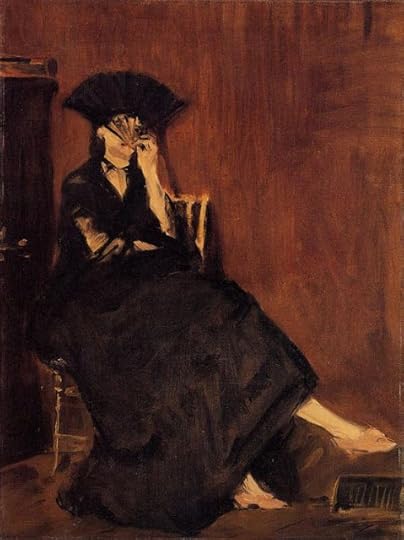 In another tale she might. It’s a ruse I can imagine Tatterhood (#15 in this series) or the Mastermaid (#7) or any number of other ingenious heroines might employ. It could even be true of Müllenhoff’s tale, but the Grimms’ story just doesn’t feel like that – at least to me. In The Girl Clad in Mouse-Skin, the mirror-opposite situation of the two brides works to their advantage. In Maid Maleen, the heroine and the false bride are so strikingly alike in their low self-esteem that on a psychological level the ugly false bride may even be Maid Maleen. In a powerful painting, False Bride Maleen, Edouard Manet makes manifest the darkness of the fairytale: the black fan guarding the face, the black dress, colour of death, the secrecy.
In another tale she might. It’s a ruse I can imagine Tatterhood (#15 in this series) or the Mastermaid (#7) or any number of other ingenious heroines might employ. It could even be true of Müllenhoff’s tale, but the Grimms’ story just doesn’t feel like that – at least to me. In The Girl Clad in Mouse-Skin, the mirror-opposite situation of the two brides works to their advantage. In Maid Maleen, the heroine and the false bride are so strikingly alike in their low self-esteem that on a psychological level the ugly false bride may even be Maid Maleen. In a powerful painting, False Bride Maleen, Edouard Manet makes manifest the darkness of the fairytale: the black fan guarding the face, the black dress, colour of death, the secrecy.
The truth comes out. The prince wishes to see the mysterious maidservant. In a final effort the false bride sends her servants to kill Maid Maleen. This shock of sudden physical danger at last provokes a reaction: Maid Maleen screams so loudly that the prince rushes to her aid. Here the Grimms’ telling of the tale diverges significantly from that of Müllenhoff, in whose version the prince’s eyes are opened ‘and he saw that she was no other than his former beautiful true bride that he had quite forgotten, that Maid Maleen was the same woman she herself had spoken about on the way to church.’ (‘…und er sah, dass sie auch keine andre sei als seine ehemalige Braut, die er ganz vergessen hatte, das die Jungfer Maleen selber sei, von er sie immer auf dem Kirchwege gesprochen’). With that, the story ends. Without more ado the prince orders Maid Maleen to be taken to a fine room, and the false bride’s head to be struck off. The patriarchy disposes. Maid Maleen herself says nothing. The Grimms do a lot more with this. First, before he actually recognises her, the prince acknowledges Maid Maleen as ‘the true bride who went with me to the church,’ confirming her as someone of great importance to him whoever she is. Only after that does he tentatively explore further: ‘On the way to the church you did name Maid Maleen, who was my betrothed bride; if I could believe it possible, I should think she was standing before me – you are like her in every respect.’ ‘You are like her in every respect.’ Following this proclamation of her worth, Maid Maleen finds her voice. Now she herself speaks out: at last comes the ‘seven long years I served for thee’ moment, the moment when, by restating her experiences, she reclaims her identity, a moment more poignant for the real suffering which has preceded it. There has been no assistance for this girl from the sun, moon and stars, no golden and silver dresses or magical gifts to barter with. No magic at all. ‘I am Maid Maleen, who for your sake was imprisoned seven years in the darkness, who suffered hunger and thirst, and has lived so long in want and poverty. Today, however, the sun is shining on me once more. I was married to you in the church, and I am your lawful wife.’ This fairy tale is a remarkable account of psychological trauma inflicted by suffering, all the more effective because of the other narratives with which it can be compared. There are many fairy tales in which a girl sets out to find a lost lover, but though her quest may be arduous she is always confident of her identity and what she is trying to achieve. When Maid Maleen escapes from her tower however, the empty landscape through which she wanders is her internal landscape, a waste land devoid of sustenance. There is nothing familiar in it, no one left who knows her, and she no longer knows herself. Physical survival is not enough. Unlike the heroines of other ‘lost bridegroom’ tales she is too unsure of herself to claim her lover and her place at his side.‘I am not the true bride.’ Not until at some deep level the prince recognises her does she recover her voice and, in telling her story, claiming her experiences and linking them together, reaffirms her identity and emerges from darkness. ‘Today the sun is shining on me once more.’ There can be little more to say. In true fairy-tale fashion the lovers live happily for the rest of their lives and the false bride has her head struck off. The story ends with a nursery rhyme which Müllenhoff places at the end of Jungfer Maleen – not as part of the tale, but as an interesting note or cross-reference. The Grimms, however, build the rhyme into the narrative so that it becomes a wonderfully evocative coda, distancing and mythologising Maid Maleen as she disappears from memory into children’s rhymes and games: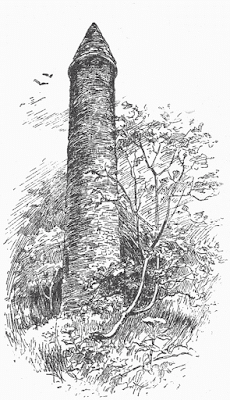
Maid Maleen - Arthur RackhamMaid Maleen - R. LeinweberThe False Bride Maleen - Edouard Manet via the website Wonderlit (I have been unable otherwise to source this)Irish Tower - Arthur Rackham

To round off my series of thirty fairytales which feature strong heroines, I'd like to repost an essay I wrote a couple of years ago about a fairy tale heroine whom many might not consider strong. For how can a girl who spends seven years imprisoned in a dark tower be an example of strength? Especially one who then seems to sink into a dark pit of post-traumatic depression? I argue that she is indeed an example of strength, and that our culture's focus on the kind of physical courage expressed in fighting and action leads us to forget or underestimate other forms of bravery. There isn't very much fighting in fairy tales! Often what they celebrate is the mental and spiritual courage all of us need to persist, endure, carry on in the face of pain, hardship, rejection, persecution. And this form of courage is often the courage of women. You can read Maid Maleen in full at this link, but I paraphrase it below. Though included in the Grimms' fairy tales (KHM 198), it's never been popular. It was first published as Jungfer MaleenSeven lang years I served for thee The glassy hill I clamb for theeThe bluidy shirt I wrang for theeAnd wilt thou no wauken and turn to me?
The time passed by, and by the decline of food and drink they knew that the seven years were coming to an end. They thought the moment of their deliverance was come; but no stroke of the hammer was heard, no stone fell out of the wall. All that prisoner-passivity and patience turns out to have been useless. The two women now seek actively to escape. They could have done so at any time before, but the weight of the king’s sentence, and their belief in it, lay upon them. Here Müllenhoff, emphasing the girls’ self-reliance, writes, ‘So they had to help themselves.’ (‘So mussten sie sich denn selber helfen.’) In the Grimms’ version Maid Maleen takes charge of their destiny but her words hint at the desperation she feels: ‘Maid Maleen said, “We must try our last chance, and see if we can break through the wall.”’ (‘Da sprach die Jungfrau Maleen: “Wir müssen das letzte versuchen und sehen, ob wir die Mauer dürchbrechen.”) Taking turns with a bread knife Maid Maleen and her maid scrape away the mortar between the stones and after three days of ‘great labour’ they push out a block and break through. Light rushes in. At last they can see the sky and breathe fresh air, but a new shock awaits: Her father’s castle lay in ruins, the town and villages were, so far as could be seen, destroyed by fire, the fields far and wide laid to waste, and no human being was visible.

At this point Müllenhof repeats the purposeful phrase, ‘So they had to help themselves.’ In the Grimms’ tale the crushing effect of the discovery is conveyed by a rhetorical question, ‘But where were they to go?’ (‘Aber wo wollten sie sich hinwenden?’) During their imprisonment the world has changed. Huge events have taken place, of which they in their isolation were completely unaware. How is a prisoner to adjust, adapt? New-born into this empty, post-apocalyptic land, their hard-won freedom brings no joy. They can only wander, starving, living on handfuls of nettles, till they cross the border into a country ruled by that very King whose son was Maid Maleen’s lover. And he is about to marry another woman. At this point in other ‘lost bridegroom’ tales there is a sense of great purpose: the girl’s arrival at the place where her lover resides is the pinnacle of her journey, and she is full of determination to win him back. By contrast Maid Maleen’s wanderings have been aimless. She’s not aspiring to find and marry her sweetheart, she’s simply trying to survive. Even when she finds work as a kitchenmaid in the palace and is employed in carrying meals to the chamber of the royal-bride-to-be, she seems stunned, passive, futureless. When forced under threat of death to impersonate the false bride, she suffers it as another indignity rather than seizing the opportunity to reveal herself to the prince. Nothing could be further from the confident resolve of the heroine of The Black Bull of Norroway, or the mutually beneficial alliance of the two brides in The Girl Clad in Mouse-Skin. Significantly at this point, as if to emphasise Maid Maleen’s degradation, her own maid disappears from the story. Maid Maleen is the servant now. And so on her way to the church, dressed as the princess she used to be and holding her true love’s hand, Maid Maleen sees a nettle growing by the wayside and it triggers a crisis. I once ate nettles raw. Can I really be Maid Maleen? Who am I? ‘Do you know Maid Maleen?’ the prince asks eagerly as she murmurs the name. And she denies it. ‘No, how should I know her? I have only heard of her.’ Is she testing him? Is this a secret reproach? I don’t think so. Maid Maleen has been a princess, a prisoner and a beggar. Her father forgot her. Her lover forgot her. The world forgot her. Now she is a kitchen-maid impersonating a princess, a pretender and cheat. ‘I am not the true bride,’ she repeats, afraid that the honest world will reject her, the foot-bridge break under her step, the church door split as she passes through. ‘I am not the true bride.’ In no other fairy tale I know of does this rejection of self occur. Maid Maleen is the true bride, but dispossessed, traumatised, damaged. There is a poignancy in her behaviour which I find deeply moving. The world has broken under her and she cannot trust it, cannot trust herself. Her loss of identity is such that she will do nothing to reinstate herself, will not speak another word. It is up to the prince to put the false bride to the test as, unable to answer his questions, she tacitly admits her deceit: I must go out unto my maid Who keeps my thoughts for me. Should we feel sorry for the ugly bride? That would be a very modern reaction. Fairy tales operate by particular rules. Youthful beauty almost always signifies goodness, ugliness its opposite: what you see is what you get. Nevertheless Heather Robbins, to whom I owe the translation of Jungfer Maleen, has made the interesting point that unlike, say, the troll bride of The Black Bull of Norroway, this particular false bride knows she is ugly, and that when she repeats Maid Maleen’s words to the prince, she is being forced to utter the truth about herself: ‘I am not the true bride’. Is it an elaborate trap? Can Maid Maleen be deliberately tricking her?
 In another tale she might. It’s a ruse I can imagine Tatterhood (#15 in this series) or the Mastermaid (#7) or any number of other ingenious heroines might employ. It could even be true of Müllenhoff’s tale, but the Grimms’ story just doesn’t feel like that – at least to me. In The Girl Clad in Mouse-Skin, the mirror-opposite situation of the two brides works to their advantage. In Maid Maleen, the heroine and the false bride are so strikingly alike in their low self-esteem that on a psychological level the ugly false bride may even be Maid Maleen. In a powerful painting, False Bride Maleen, Edouard Manet makes manifest the darkness of the fairytale: the black fan guarding the face, the black dress, colour of death, the secrecy.
In another tale she might. It’s a ruse I can imagine Tatterhood (#15 in this series) or the Mastermaid (#7) or any number of other ingenious heroines might employ. It could even be true of Müllenhoff’s tale, but the Grimms’ story just doesn’t feel like that – at least to me. In The Girl Clad in Mouse-Skin, the mirror-opposite situation of the two brides works to their advantage. In Maid Maleen, the heroine and the false bride are so strikingly alike in their low self-esteem that on a psychological level the ugly false bride may even be Maid Maleen. In a powerful painting, False Bride Maleen, Edouard Manet makes manifest the darkness of the fairytale: the black fan guarding the face, the black dress, colour of death, the secrecy. The truth comes out. The prince wishes to see the mysterious maidservant. In a final effort the false bride sends her servants to kill Maid Maleen. This shock of sudden physical danger at last provokes a reaction: Maid Maleen screams so loudly that the prince rushes to her aid. Here the Grimms’ telling of the tale diverges significantly from that of Müllenhoff, in whose version the prince’s eyes are opened ‘and he saw that she was no other than his former beautiful true bride that he had quite forgotten, that Maid Maleen was the same woman she herself had spoken about on the way to church.’ (‘…und er sah, dass sie auch keine andre sei als seine ehemalige Braut, die er ganz vergessen hatte, das die Jungfer Maleen selber sei, von er sie immer auf dem Kirchwege gesprochen’). With that, the story ends. Without more ado the prince orders Maid Maleen to be taken to a fine room, and the false bride’s head to be struck off. The patriarchy disposes. Maid Maleen herself says nothing. The Grimms do a lot more with this. First, before he actually recognises her, the prince acknowledges Maid Maleen as ‘the true bride who went with me to the church,’ confirming her as someone of great importance to him whoever she is. Only after that does he tentatively explore further: ‘On the way to the church you did name Maid Maleen, who was my betrothed bride; if I could believe it possible, I should think she was standing before me – you are like her in every respect.’ ‘You are like her in every respect.’ Following this proclamation of her worth, Maid Maleen finds her voice. Now she herself speaks out: at last comes the ‘seven long years I served for thee’ moment, the moment when, by restating her experiences, she reclaims her identity, a moment more poignant for the real suffering which has preceded it. There has been no assistance for this girl from the sun, moon and stars, no golden and silver dresses or magical gifts to barter with. No magic at all. ‘I am Maid Maleen, who for your sake was imprisoned seven years in the darkness, who suffered hunger and thirst, and has lived so long in want and poverty. Today, however, the sun is shining on me once more. I was married to you in the church, and I am your lawful wife.’ This fairy tale is a remarkable account of psychological trauma inflicted by suffering, all the more effective because of the other narratives with which it can be compared. There are many fairy tales in which a girl sets out to find a lost lover, but though her quest may be arduous she is always confident of her identity and what she is trying to achieve. When Maid Maleen escapes from her tower however, the empty landscape through which she wanders is her internal landscape, a waste land devoid of sustenance. There is nothing familiar in it, no one left who knows her, and she no longer knows herself. Physical survival is not enough. Unlike the heroines of other ‘lost bridegroom’ tales she is too unsure of herself to claim her lover and her place at his side.‘I am not the true bride.’ Not until at some deep level the prince recognises her does she recover her voice and, in telling her story, claiming her experiences and linking them together, reaffirms her identity and emerges from darkness. ‘Today the sun is shining on me once more.’ There can be little more to say. In true fairy-tale fashion the lovers live happily for the rest of their lives and the false bride has her head struck off. The story ends with a nursery rhyme which Müllenhoff places at the end of Jungfer Maleen – not as part of the tale, but as an interesting note or cross-reference. The Grimms, however, build the rhyme into the narrative so that it becomes a wonderfully evocative coda, distancing and mythologising Maid Maleen as she disappears from memory into children’s rhymes and games:

Maid Maleen - Arthur RackhamMaid Maleen - R. LeinweberThe False Bride Maleen - Edouard Manet via the website Wonderlit (I have been unable otherwise to source this)Irish Tower - Arthur Rackham
Published on October 06, 2020 04:34
September 29, 2020
Strong Fairy Tale Heroines #30: VASILISA THE PRIEST'S DAUGHTER
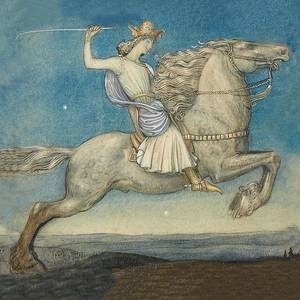
This Russian tale from the collection of Aleksander Afanas’iev, translated by Norbert Guterman, brings my series of traditional fairy tales with strong heroines to a close. There are many Vasilisas in Russian fairy tales, and most of them are strong. In the well-known story of Vasilisa the Beautiful, for example, a young woman is sent to borrow fire from the witch Baba Yaga, while Vasilisa the Wise (#17 in this series) is a magic-worker who rescues the prince from her father the Sea King.
Vasilisa the Priest's Daughter works no magic of any kind. She simply uses wits and nerve to out-smart and rebuke an impertinently curious king. Her preferred way of life – dressing and behaving as a young man – is accepted by her father and raises no eyebrows among her neighbours, and she easily evades the efforts of the king – and the witch who advises him – to discover her real gender. I particularly like the trumphant note she sends him, at the end, where she compares him to a raven and herself to a falcon. That's telling him!
Those of you who've been following the series will remember similar attempts by the king and his pet lion in Grimms’ The Twelve Huntsmen #27 – and by a genie and his mother in the Romanian tale The Princess in Armour #3. (Don't you love the infinite variations on themes in fairy tales?) Naturally all such ingeniously contrived tricks are doomed to fail, and why? Because they rely upon crude and inadequate stereotypes of the character and capacities of women. This is a deliberate narrative choice: we are absolutely expected to enjoy seeing the heroines of these stories run rings around their often ridiculous male adversaries.
Still, the women of fairy tales have no real need to impersonate men, any more than the male heroes of fairy tales often resemble warriors with swords. Far more frequently, fairy tales celebrate humble protagonists, underdogs who succeed beyond their wildest dreams through chutzpah, kindness, endurance and luck. Girls and women in fairy tales are no less energetic, witty, clever, brave and persistent than the brothers and lovers they often rescue. In fact, they are often more so! My next post will examine one more story in close detail, before I move on to a different subject.
Witches!

In a certain land, in a certain kingdom, there was a priest called Vasily who had a daughter named Vasilisa Vasilyevna. She wore man’s clothes, rode horseback, was a good shot with a rifle and did everything in a quite unmaidenly way, so that only a very few people knew that she was a girl: most people thought she was a man and called her Vasily Vasilyevich, all the more so because she was very fond of vodka. This is, as is well known, entirely unbecoming to a maiden…
One day, King Barkhat – for the was the name of the king of the country – went hunting game and he met Vasilisa Vasilyevna. She was riding horseback in men’s clothes and was also hunting. When he saw her, King Barkhat asked his servants, ‘Who is that young man?’ One servant answered him, ‘Your majesty, that isn’t a man but a girl; I know for sure that she is Vasilisa Vasilyevna, the daughter of the priest Vasily.’
As soon as the king returned home he wrote a letter to the priest Vasily asking him to permit his son Vasily Vasilyevich to visit him and eat at the king’s table. Meanwhile, he himself went to the little old backyard witch and began questioning her as to how he could find out whether Vasily Vasilyevich was really a girl.
The little old witch said to him, ‘Hang up an embroidery frame on the right side of your chamber, and on the left side hang up a gun: if she is really Vasilisa Vasilyevna she will notice the embroidery frame first; if she is Vasily Vasilyevich she will notice the gun.’ The king followed the little old witch’s advice and ordered his servants to hang up an embroidery frame and a gun in his chamber.
As soon as the king’s letter reached Father Vasily and he showed it to his daughter, she went to the stable, saddled a grey horse with a grey mane, and went straight to King Barkhat’s palace. The king received her; she politely said her prayers, made the sign of the cross as is prescribed, bowed low to all four sides, graciously greeted King Barkhat, and entered the palace with him. They sat together and began to drink heady drinks and eat rich viands. After dinner, Vasilisa Vasilyevna walked with King Barkhat through the palace chambers; as soon as she saw the embroidery frame she began to reproach the king: ‘What kind of junk do you have here, King Barkhat? In my father’s house there is no trace of such womanish fiddle-faddle, but in King Barkhat’s house, womanish fiddle-faddle hangs in the chambers!’ Then she politely said farewell and rode home, and the king was none the wiser as to whether she was really a girl.
And so two days later – no more! – King Barkhat sent another letter to the priest Vasily, asking him to send his son Vasily Vasilyevich to the palace. As soon as Vasilisa Vasilyevna heard about this she went to the stable, saddled a grey horse with a grey mane, and rode straight to King Barkhat’s palace. She graciously greeted him, politely said her prayers to God, made the sign of the cross as is prescribed and bowed low to all four sides. King Barkhat had been advised by the little old backyard witch to order kasha cooked for supper, and to have it stuffed with pearls. The little old witch had told him that if the youth was really Vasilisa Vasilyevna, he would put the pearls in a pile, and if he was Vasily Vasilyevich, he would throw them under the table.
Supper time came. The king sat at table and placed Vasilisa Vasilyevna on his right hand, and they began to drink heady drinks and eat rich viands. Kasha was served after all the other dishes, and as soon as Vasilisa Vasilyevna took a spoonful of it and discovered a pearl, she flung it under the table together with the kasha and began to reproach King Barkhat. ‘What kind of trash do they put in your kasha?’ she said. ‘In my father’s house there is no trace of such womanish fiddle-faddle, yet in King Barkhat’s house, womanish fiddle-faddle is put in the food!’ Then she politely said farewell to King Barkhat and rode home. Again the king had not found out whether she was really a girl, though he badly wanted to know.
Two days later, upon the advice of the little old witch, King Barkhat ordered that his bath be heated; she had told him that if the youth really was Vasilisa Vasilyevna he would refuse to go to the bath with him. So the bath was heated.
Again King Barkhat wrote a letter to the priest Vasily, telling him to send his son Vasily Vasilyevich to the palace for a visit. As soon as Vasilisa Vasilyevna heard about it, she went to the stabel, saddled her grey horse with the grey mane, and galloped straight to King Barkhat’s palace. The king went out to receive her on the front porch. She greeted him civilly and entered the palace on a velvet rug; having come in, she politely said her prayers to God, made the sign of the corss as is prescribed, and bowed very low to all four sides. Then she sat at table with King Barkhat and began to drink heady drinks and eat rich viands.
After dinner the king said, ‘Would it not please you, Vasily Vasilyevich, to come with me to the bath?’
‘Certainly, your Majesty,’ Vasilisa Vasilyevna answered. ‘I have not had a bath for a long time and should like very much to steam myself.’ So they went together to the bathhouse. While King Barkhat undressed in the anteroom, she took her bath and left. So the king did not catch her in the bath either. Having left the bathhouse, Vasilisa Vasilyevna wrote a note to the king and ordered the servants to hand it to him when he came out. And this note ran:
‘Ah, King Barkhat, raven that you are, you could not surprise the falcon in the garden! For I am not Vasily Vasilyevich, but Vasilisa Vasilyevna.’ And so King Barkhat got nothing for his trouble, for Vasilisa Vasilyevna was a clever girl, and very pretty too!
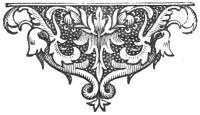
Picture credits:As there seem to be no illustrations of this fairy tale, I have chosen to use 'A prince arrived' by John Bauer.
Published on September 29, 2020 02:15
September 22, 2020
Strong Fairy Tale Heroines #29: PRINCE HLINI AND SIGNY

This Icelandic tale was collected by Jón Árnason (1819 – 1888) whose six volumes of folk tales and fairy stories were edited and published in Reykjavik between 1954-61. The translation is from Icelandic Folk and Fairy Tales, selected and translated by May and Hallberg Hallmundsen, Iceland Review Library, 1987. In their introduction they comment that ‘every child in Iceland’ recognises ‘Jón Árnason’s Folktales’ – and no wonder, for they are robust and remarkable.
‘They are written,’ say the translators, ‘in the everyday spoken Icelandic of the time when they were recorded, many of them taken down word for word as told by the storytellers – farmers, laborers, housewives, maids. … The best way to render such narratives into English, we concluded, would be in plain unadorned prose that was faithful to the meaning if not to every word of the story. So, wherever the original text is bumpy or awkward – and it is in many places – we tried to smooth it over and we did not hesitate to reshape of switch sentences around if we thought it was inducive to a clearer understanding or a more straightforward narrative.’ I have taken the occasional similar liberty with their translation: for example, sometimes changing reported speech into dialogue.
This story needs almost no introduction: it speaks for itself – but I will say that Signý’s rescue of a prince from an enchanted sleep is an interesting role reversal of the Sleeping Beauty!

Once upon a time there was a king and a queen in their kingdom. His name was Hringur, but the queen’s name is not known. They had one son called Hlini. He was a promising lad who grew up to be a great champion, and the story has it that there was a crofter and his wife living near the palace grounds. They had a daughter named Signý.
One day the prince was out hunting with some of his men, and when they had felled a few animals and several birds and were preparing to go home, a fog descended upon them, so dense that the men lost sight of their prince. After searching in vain for a very long time they went back to the palace and told the king they had lost Hlini and couldn’t find him anywhere. This sad news greatly affected the king, and the next day he sent out a large party of men to look for his son. They searched until evening without finding him, and this went on for three days; Hlini was nowhere to be found. Sick with grief, the king took to his bed and let it be known throughout his land that whoever could find his son would be rewarded with half his kingdom.
When Signý heard of this, she told her parents about it, asked them for food and new shoes – which they gave her – and immediately set off. She walked for the better part of a day, and towards evening she came upon a cave. Entering it, she saw two beds, one embroidered with silver and the other with gold. When she drew closer, there was the prince lying asleep in the gold-embroidered one, and she tried to wake him but she couldn’t. Then she took a better look around her and saw that there were runes scored into the wooden heads of the beds, spelling out words she didn’t understand. So she went and hid herself in the nook behind the cave door.
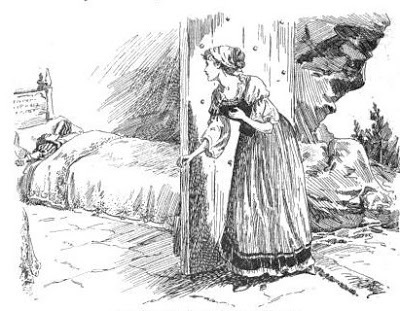
No sooner was she hidden than she heard a great rumble and saw two very large-featured jötunns, or giantesses, coming. As they stepped into their cave, one of them said, ‘Fy, fo, there’s a smell of humans in here.’
‘It’s only Prince Hlini,’ said the other.
They went up to the bed where the prince was sleeping and said,
Sing, sing, my swans Sing Prince Hlini awake.
The swans sang, and Hlini woke up. The younger giantess asked him if he wanted something to eat, and he said no. Then she asked if he wanted to marry her, and he said no. Hearing that, she shouted out,
Sing, sing, my swans Sing Prince Hlini asleep.
They sang and he fell asleep. The two giantesses then took their clothes off and went to sleep in the silver-embroidered bed.
When they rose the following morning, they roused Hlini and offered him food, which he rejected. Then the younger one asked again if he would marry her. He said no, and with that they put him to sleep the same way as before, and left.
When she was sure they had gone, Signý crawled out ofher nook and said:
Sing, sing, my swans Sing Prince Hlini awake.
The prince woke up. He greeted her with joy and asked for the news and what was happening. She told him everything she knew and then asked what had happened to him. ‘After I was parted from my men in the mist,’ he said, ‘two giant women found me and brought me here, and one of them is trying to make me marry her.’
Signý said, ‘You should agree to marry her on condition that she tells you what the carved runes on the beds mean, and what the two of them get up to all day.’
The prince said he would do as she advised. Then he took a chessboard that was there, and asked Signý to play with him. They played until evening, but when dusk began to fall she told him to get back on the bed. Then she said:
Sing, sing, my swans Sing Prince Hlini asleep.
The prince fell asleep, and Signý hid herself back in her nook. Very soon afterwards, she heard the giantesses coming. They slouched into the cave, monstrous-looking as they were, and while the eldest one cooked a meal, the youngest went over to the bed, woke Hlini and asked if he would eat. This time he accepted. When he had finished his meal, the giantess asked if he would marry her. He replied that he would, provided that she tell him the meanings of the runes on the two beds. ‘Easily done,’ she said, and told him that they meant:
Glide, glide, my good bed, Wherever I want to go.
That was all fine, he said, but she would have to tell him one thing more – namely, what did the two of them do in the woods all day?
‘We go hunting for birds and animals,’ said the giantess, ‘and when we are resting we sit beneath an oak tree and toss our life-egg back and forth between us.’
Prince Hlini asked what would happen if it broke. That would never happen, the giantess told him, but if it did, they would both die. Hlini told her he was well pleased she had confided in him, but now, he said, he was tired and wanted to rest till morning.
‘As you wish,’ said the giantess.
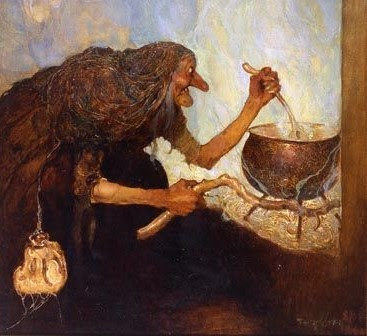
Next morning she woke the prince for breakfast, which he accepted. Then she offered to let him come out into the woods with them, but he told her he preferred to stay home. So the giantess put him to sleep and left with her companion.
Once Signý was sure they had gone, she crept out of hiding to wake the prince. ‘Now let us go out into the woods where the giantesses are,’ she said. ‘Take your spear, and when they start tossing their egg, throw the spear at it and be sure not to miss, for your life depends on it!’
The prince agreed to this plan, and they stood together on the bed, saying:
Glide, glide, my good bed, Out into the woods.
The bed took off at once and didn’t stop until they reached a huge oak tree deep in the woods. There, Signý and Hlini heard roars of laughter. Signý told the prince to climb down into the branches. He did, and there below him he saw the two giantesses, one of them holding a golden egg in her hand. She tossed it to the other, and at the same time Hlini flung his spear. It struck the egg, breaking it, and the giantesses fell to the earth and died.
Then the prince climbed down from the oak, and he and Signý returned to the cave. They collected everything of value, loaded it on to the beds and flew straight to Signý’s cottage with all the treasure. The crofter and his wife welcomed the couple with joy, and Prince Hlini stayed at the cottage that night.
Early next morning, Signý went to the palace, stood before the king and hailed him. ‘Who are you?’ the king asked, and she told him she was just the crofter’s daughter from outside the grounds, and asked him what he would say if she brought back his son. The king replied that the question was not worth an answer, she would hardly be able to find his son, ‘since none of the men in my kingdom have been able to.’ Signý asked again whether he would reward her in the same way as he had promised the others, if she brought the prince home. The king said he would.
With that, Signý went back to the cottage and bid the prince come with her to the king’s palace, where she led him before his father. The king rejoiced to see his son, and asked what had happened to him since the time he was parted from his men. Sitting down on a throne, Hlini invited Signý to sit beside him, and told all his story just as I have done here. He added that he owed his life to Signý and he begged his father’s permission to marry her. The king gave his consent and a great feast was prepared. The wedding lasted a week, all the noblest people in the country were invited, and the prince and Signý loved each other long and well. So ends the story!

Picture credits:
Young man and misty woods ('The Hulder That Vanished') - by Theodor Kittelsen
Signý Enters the Trolls' Cave - Artist unknown
Troll wife cooking - by John Bauer
Published on September 22, 2020 01:41
September 15, 2020
Strong Fairy Tale Heroines #28: 'THE HEN IS TRIPPING IN THE MOUNTAIN'
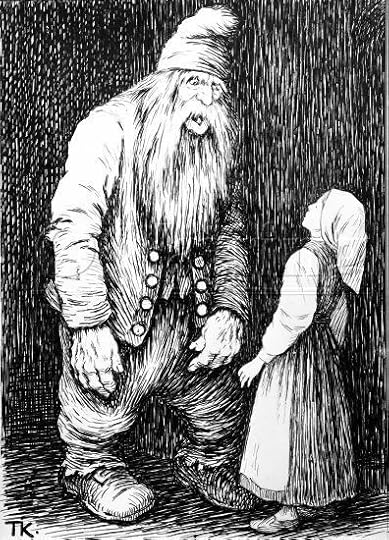 'Will you be my sweetheart?'
'Will you be my sweetheart?'This story was collected by Jørgen Moe in Ringerike, eastern Norway, and published in Asbjørnsen & Moe’s Norske Folkeeventyr in 1852; it’s a good example of ATT Type 311, Rescue by the Sister. In this type of tale, three sisters set out on some adventure, the two eldest fail and the youngest rescues them: the Welsh Romany tale, The Three Sisters, #2 in this series is a striking and unusual example. In this kind of story princes do not feature, and there is rarely any wedding at the end.
The best-known example is probably the Grimms’ tale Fitcher’s Bird(KHM 46), a dark and curious tale which goes like this: a wizard kidnaps one of three sisters to be his wife, and like Bluebeard forbids her to open a particular door in his house. He also gives her an egg which she must carry about and keep with her. When the wizard is out, the girl looks into the forbidden room and finds a basin of blood and human body parts. She drops the egg and gets blood on it which she cannot remove. The wizard returns and kills her.
The same thing happens to the second sister; the third sister, however, is clever enough to put the egg safely away before looking into the forbidden room. There, finding her sisters dead and in pieces, she gathers the parts together and brings them back to life. The returning wizard believes he has been obeyed (seeing no sign of blood on the egg) and wants her for his bride. From now on he has no power over her.
She tells him to carry a basket of gold to her parents’ house as a dowry, but hides her sisters under the gold (feasibility has no place in fairy tales), ordering him not to rest or sit down on the way, for she will be watching him from the window. The wizard toils under the burden, but each time he tries to rest one of the sisters calls out. Certain that his betrothed is watching him, he carries the sisters and the gold to their home. Back at his house, the girl prepares a marriage feast and invites the wizard’s friends. She sets a skull in the window, wreaths it with bridal flowers, smears herself with honey and rolls in feathers till she looks like ‘a wondrous bird’, and sets off home. On the way she meets the arriving guests who greet her in rhyme as ‘Fitcher’s Bird’ coming from ‘Fitcher’s house’; the disguised girl tells them that all is ready and the bride is peeping from the window. As soon as the wizard and all his friends are in the house, her brothers and kinsmen arrive (warned by her sisters), barricade the doors and burn it down with the wizard and his crew inside.
The Hen Tripping in the Mountain is a lot more rustic and comical than Fitcher’s Bird, and the troll is so simple and stupid and cowardly that it’s hard not to feel a tiny bit sorry for him.
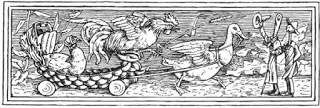
There was once an old woman who lived with her three daughters way up under a mountain ridge. She was so poor she owned nothing but a hen, the apple of her eye. It was always cackling at her heels and she was always running after it. Well one day, the hen vanished. The old woman went round and around the cottage searching and calling, but the hen was gone, and there was no finding it.
So the woman told her eldest daughter, ‘You’ll have to go out looking for our hen. We have to get it back – even if we have to dig it out of the the hill.’
The daughter went off looking and calling for it. She went all over, here and there, but no trace of the hen could she find, till just as she was about to give up, she heard someone calling from over by the cliffs,
Your hen is tripping in the mountain! Your hen is tripping in the mountain!
So she headed that way to see what it was, but right by the cliff foot she fell through a trap door, deep, deep down into an underground vault. At the bottom she made her way through many rooms, each finer than the first, but in the innermost room a big ugly mountain troll came up to her and said, ‘Will you be my sweetheart?’
‘No I won’t!’ she said, ‘not at any price!’ She wanted to get back above ground at once, and find her lost hen. Then the mountain troll was so angry he took her up and wrung off her head, and threw her head and her body down into the cellar.
While this was going on, her mother sat at home waiting and waiting, but no daughter came back. She waited a while longer, and then told her middle daughter to go our and call for her sister, and, she added, ‘you can call for our hen at the same time.’
So the second sister went out, and the same thing happened to her; she went about calling and looking, and she too heard a voice from the rock face saying,
Your hen is tripping in the mountain! Your hen is tripping in the mountain!
This was very strange, she thought, so she went to see what it could be, and she too fell through the trap door, deep, deep down into the vault. Then she went through all the rooms to the innermost one, where the mountain troll came up to her and asked if she would be his sweetheart? No, she would not! All she wanted was to get above ground again and look for her hen which was lost. So the troll got angry and wrung her head off, and threw head and body down into the cellar.
Well, when the old woman had sat and waited seven lengths and seven breadths for her second daughter, and no sign of her was to be seen or heard, she said to the youngest, ‘Now you really will have to go out after your sisters. It was bad enough to lose the hen, but it would be much worse to lose both your sisters, and you can always give the hen a call or two at the same time.’
Off went the youngest girl, and she went up and down hunting for her sisters, and calling the hen, but neither saw nor heard anything of any of them until at last shecame up to the cliff face and heard how something said:
Your hen is tripping in the mountain! Your hen is tripping in the mountain!
She too went to see what it was and fell down through the trap door, deep, deep down into the vault. When she reached the bottom she went from room to room, each one grander than the other, but she wasn’t at all scared and took good care to look around her, and she spotted the cellar door and looked through it and there were her sisters lying dead! And the moment she got the door shut, the mountain troll came up to her.
‘Will you be my sweetheart?’ he asked.
‘Yes, certainly!’ said she, for she could see quite well what had happened to her sisters. And when the troll heard that, he gave her the finest clothes in the world and anything else she asked for, he was so glad that anyone would be his sweetheart.
But after she’d been there for a while, there came a day when she was very downcast and silent. The troll asked why she was moping.
‘Oh,’ said the girl, ‘it’s because I can’t get home to my mother. She’ll be hungry and thirsty, I’m sure, and there’s no one to stay with her either.’
‘Well you can’t go to her,’ said the troll, ‘but put some food in a sack and I’ll carry it to her.’
Well she thanked him for this, and said she would. But she put lots of gold and silver at the bottom of the sack, and laid just a little food at the top, and gave the sack to the troll and told him not to look into it. The troll promised he wouldn’t, and set off, but the girl peeped after him through the trap door and saw that when he had gone just a little way, the sack was so heavy he put it down to untie the neck and look inside it. Then she called out,
I see what you’re up to!I see what you’re up to!
 'I can still see you!'
'I can still see you!'‘Those are damn sharp eyes you’ve got in your head,’ said the troll, and he didn’t dare to try it any more.
When he reached the widow’s cottage he threw the sack in through the door. ‘Here’s some food from your daughter. She lacks for nothing!’ he said.
Now one day, when the girl had been in the hill for a good while longer, a billy goat fell down through the trap door. ‘Who said you could come in, you shaggy-bearded beast?’ said the troll in a fury, and he took the goat and wrung its head off and threw it into the cellar.
‘Oh! What did you do that for?’ said the girl. ‘I could have had that goat to play with; it’s dull enough down here.’
‘Well don’t sulk about it,’ said the troll. ‘I can soon bring it back to life, I can,’ and he took a flask which hung on the wall, put the goat’s head back on, smeared it with some ointment out of the flask, and up sprang the billy-goat as frisky as ever.
‘Oh ho,’ thought the girl, ‘that flask is worth something, it is!’ So she waited for a day when the troll was out, then took her eldest sister and put her head back on. She rubbed her with ointment from the flask, the way she’d seen the troll do to the billy-goat, and her sister came back to life at once. Then the girl stuffed her into a sack, covered her up with a layer of food, and said to the troll when he came back,
‘My dear friend, it’s time to take some food to my mother again. Poor thing, she must be hungry and thirsty, and with no one to look after her! But you mustn’t look in the sack.’
The troll was willing to take the sack, all right, but when he had got a bit on the way it was so heavy that that he thought he would see what was in it. ‘No matter how sharp her eyes are, she won’t see me from here,’ he thought. But as he set the sack down to look in it, the girl who was sitting inside called out,
I see what you’re up to!I see what you’re up to! ‘Those are damn sharp eyes you’ve got!’ said the troll, who thought it was the girl in the mountain who was calling. He didn’t dare try looking inside any more, but carried it to her mother’s house as fast as he could, and when he got there he threw the sack in through the door, bawling out, ‘Here’s meat and drink from your daughter! She has everything she wants!’
Well, the girl waited a while longer, and then she did the same thing with her other sister. She set her head back on her shoulders, smeared her with ointment and stuffed her into the sack along with as much gold and silver as would fit. Then she covered everything with a thin layer of food and asked the troll to take it to her mother. This time the sack was so heavy he could barely stagger along under it, so he put it down and was just going to untie the string and look in, when the girl inside shouted:
I see what you’re up to!I see what you’re up to!
‘The deuce you do!’ said the troll. ‘I never knew anyone with such damn sharp eyes!’ and he dared not take another peep, but staggered along to the old woman’s house, threw the sack in through the door and roared, ‘More food from your daughter! You see – she wants for nothing!’
A few days later when the troll was going out for the evening, the girl pretended to be poorly. ‘There’s no use you coming home any time before twelve midnight,’ she said. ‘I simply won’t be able to get supper ready till then, I’m feeling so sick and feeble.’ But when the troll had gone out, she stuffed some of her clothes with straw and stood this straw girl up in the corner by the hearth with a stirrer in her hand, so it looked as if she were standing there herself. After that she hurried off home and hired a hunter to come with her and stay with them in her mother’s cottage.
So when it was twelve midnight, the troll came home. ‘Bring me my food!’ he said to the straw maiden, but she didn’t move or answer.
‘Bring me my food, I say!’ said the troll again, ‘I’m starving!’ Still she didn’t answer.
‘Bring the food!’ yelled the troll. ‘Listen to what I say and do what you’re told, or I’ll give you such a wake-up, that I will!’ But the girl just stood there. Then he flew into a terrible rage and gave her such a kick that the straw flew up to the ceiling, and he saw he had been tricked. He searched high and low until he came to the cellar and found both the girl’s sisters were gone. Now he understood what had happened and ran down to the cottage crying, ‘I’ll pay her out for this!’ but when they saw him coming, the hunter fired. The shot banged out, and the troll mistook it for thunder. He turned in fright and ran for home as fast as his legs would carry him, but just as he reached his trap door, what do you think! – the sun rose, and he burst into pieces.
Oh, there’s plenty of gold and silver down under that trap door still – if we only knew how to find it!
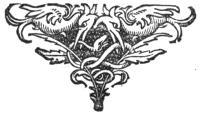
Picture credits: Art by Theodor Kittelsen
Published on September 15, 2020 01:46
September 8, 2020
Strong Fairy Tale Heroines #27: THE TWELVE HUNTSMEN
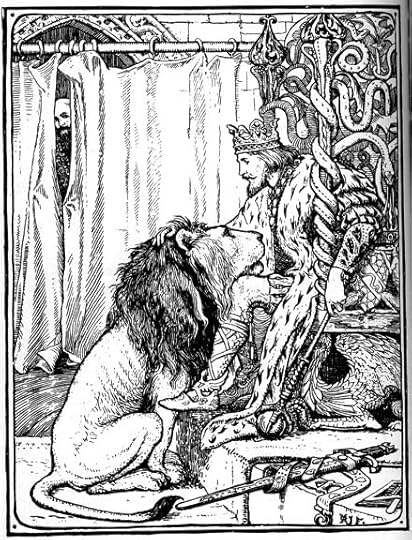
If we approach fairy tales expecting nothing but sexist stereotypes, we will miss the irony, the inflections; we won’t get the jokes. In this tale of the Brothers Grimm, a princess dresses herself and eleven ladies-in-waiting as huntsmen and goes to work for her lover, a king who has promised his dying father to marry a different woman.
This king has a talking lion. (As you do.) The lion suspects the twelve young huntsmen of being women. He sets traps to get them to betray themselves – such as an array of twelve spinning wheels which he assures the king these ‘women’ will be unable to resist. You have to imagine this story being told aloud in mixed company, at a time when spinning was a woman’s repetitive, endless work. It’s as if, in a modern version, the lion had set out a line of twelve vacuum cleaners! Readers who take it at face value are missing the comedy of the princess’s satirical aside to her followers as they stride past: ‘Hold back, girls, don’t give those spinning wheels a glance…’
It is all too easy to misinterpret a tale when it’s pinned to the page like a dead butterfly – still more so when the original transcript is over two centuries old and even the English translation was made over 130 years ago. The classic translation of the Grimms’ tales into English is the one by Margaret Hunt (published 1884), whose clear, unadorned style now unavoidably feels somewhat stiff. I’ve stuck quite closely to her version for this post, I didn’t want to change it much; but I have loosened it up a little. It’s best to regard ‘the story on the page’ in much the same way as we regard sheet-music: it requires performance – the voice of the story-teller – to bring it to multi-dimensional life. But the information on the page still has to be examined and respected. Like some others in the Grimms’ collection, The Twelve Huntsmen directs sly, subversive humour at male assumptions about female ability, and if we fail to notice when a story is inviting us to laugh, it’s we who are naïve.

Once upon a time, a king’s son was betrothed to a woman he loved very much. One day when they were sitting together, and very happy, news came that the prince’s father lay on his deathbed and wanted to see his son once more before the end. So the prince said to his beloved, ‘Though I have to leave you, I give you this ring to remember me by, and when I am king I will return for you.’
Away he rode, but when he came to his father’s bedside the old man was desperately ill and near death. ‘My dear son,’ said he, ‘now that I see you, promise me that you will marry as I advise,’ and he named another king’s daughter to be his bride. The son was too distraught to think what he was doing and said, ‘Yes dear father, yes, whatever you wish shall be done.’ On hearing these words the old king closed his eyes and died.
So after the son had been proclaimed king and the period of mourning was over, he felt compelled to keep the promise he had made to his father, and he sent for permission to court the other king’s daughter’s, and permission was granted. When his lover heard of this she was so unhappy she nearly died. Her father said to her, ‘Dear child, what makes you so sad? Tell me what you want; anything in my power to grant shall be yours.’ The young woman thought for a moment and said, ‘My dear father, I wish for eleven girls just like myself in face, figure and height.’ So her father searched throughout his kingdom until eleven young women were found who were just like his daughter in face, figure and height.
When they were assembled, the king’s daughter had twelve suits of huntsmen’s clothes made, all alike, and she and the eleven girls put them on and rode away together to the court of her former lover, where she asked if he would take twelve fine huntsmen into his service. The king did not recognise her, but the huntsmen were all such handsome fellows he said, yes, willingly he would hire them! And so they became the king’s royal huntsmen.
Now the king had a lion, and this lion knew everything. Nothing could be kept from him, and one evening he said to the king, ‘You think you have twelve huntsmen?’
‘Of course I have twelve huntsmen!’
‘You are wrong,’ said the lion, ‘they are twelve girls.’
The king couldn’t believe this, so the lion told him to throw handfuls of dried peas over the floor of the antechamber: ‘And then you’ll see! Men tread firmly, so the peas won’t move when they step on them, but girls trip and skip and slide their feet, and the peas will roll in all directions.’ The king liked this idea, so he ordered the peas to be thrown on the floor.
But one of the king’s servants who was friendly with the huntsmen had overheard what the lion said, so he ran to them with the news. ‘The lion wants to make the king think you are girls!’ The king’s daughter thanked him. When he had gone she said to her women, ‘Time to show your strength, girls! Make sure you tread firmly on those peas!’ And next morning when the king called the twelve huntsmen before him, they walked into the antechamber with such a strong, sure tread that not a single pea rolled or even shifted.
After they had left, the king turned on the lion: ‘What you told me was false! They walk just like men.’ The lion replied, ‘They were pretending. Someone must have warned them! But here’s an idea: bring twelve spinning wheels into the antechamber. Then you’ll see! They’ll be so thrilled they won’t be able to resist going over and examining them. No man would do that!’ This advice pleased the king, and he had the spinning wheels placed in the antechamber.
But the servant who was friendly to the huntsmen told them about this plan too. ‘Hang on to yourselves, girls!’ said the king’s daughter to her eleven women. ‘Don’t give those spinning wheels a glance!’ So when the king summoned them, the twelve huntsmen strode through the antechamber without so much as turning their heads to look at the spinning wheels. And the king said to the lion, ‘You’ve been proved false again. They’re men! They showed no interest in the spinning wheels.’
‘They knew we were trying to trick them,’ said the lion, ‘that’s why they restrained themselves.’ But the king no longer trusted the lion’s opinions. The twelve huntsmen became his companions whenever he went out hunting, and he valued them more and more.
One day as they were out riding in the forest, news came that the king’s new bride-to-be was approaching with her retinue. When his true lover heard this, her heart hurt so much she fell fainting to the ground. Seeing the accident that had befallen his dear huntsman, the king ran to help him, grasped his hand and drew off the glove that covered it. Then he saw the ring he had given his first beloved, and looking again in her face, he recognised her. His heart was so touched that he kissed her, and said as she opened her eyes, ‘You are mine and I am yours, and no one in the world can change that.’ He sent a messenger to the other bride, begging her to return to her own kingdom, for he had a wife already and someone who has found an old key doesn’t need a new one. So their wedding was celebrated, and the lion was vindicated and taken back into favour – for after all, he had got one thing right.
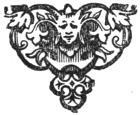 Picture credits: The Twelve Huntsmen by HJ Ford, illustration from The Green Fairy Book.
Picture credits: The Twelve Huntsmen by HJ Ford, illustration from The Green Fairy Book.
Published on September 08, 2020 02:24
August 27, 2020
Strong Fairy Tale Heroines #26: KATE CRACKERNUTS
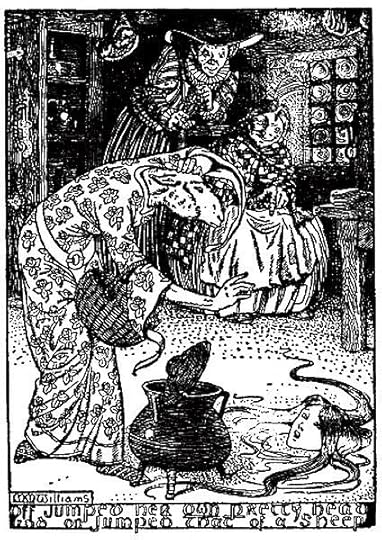
Kate Crackernuts is the same story type as the Norwegian Tatterhood (#15 in this series) in which two sisters or stepsisters stick together through thick and thin, and the plain or ugly sister rescues the pretty one from a witch’s spell and manages things so that in the end they both marry princes (whether the prince wants to or not). Kate Crackernuts in this tale rescues her prince as well.
The story was first collected by Duncan J Robertson (1860-1941) – poet, naturalist, County Clerk of Orkney for over 50 years and some time owner of Eynhallow, a small and now deserted island in Eynhallow Sound between Rousay and Mainland Orkney. (The island is said to have been first inhabited by the Finfolk or mer-people, who were driven out bythe first human settler, the Goodman of Thorodale.)
Anyway, Robertson published Kate Crackernuts in Longmans Magazine, vol xiii (1888/9). I wasn't able to consult this version, since the only online edition is unavailable to anyone outside the United States. But Andrew Lang republished the story in Folklore, Sept. 1890 (vol 1, no. iii) and it’s probably safe to assume he made few if any changes, since the narrative is quite fragmented. It keeps dropping in and out of a Scots, not Orcadian dialect – which suggests to me that it may not in fact have been collected on Orkney – and various chunks of the story are told in a rather stilted summary. For example: ‘In consequence, the answer at the henwife’s house was the same as on the preceding day’, or ‘A magnificent hall is entered, brightly lighted up, and many beautiful ladies surround the prince,’ etc. To make it flow and be enjoyable to read or listen to, it absolutely has to be expanded and partly rewritten. This I have done – and Joseph Jacobs did so too when he included it in his famous (somewhat misnamed) English Fairy Tales of 1890. He complained that the tale was ‘very corrupt, both of the girls being called Kate’, and renamed one of them Anne, doubtless to prevent child readers getting muddled. I don’t personally think this was necessary, and I believe the two Kates are likely to be authentic and not a mistake at all.
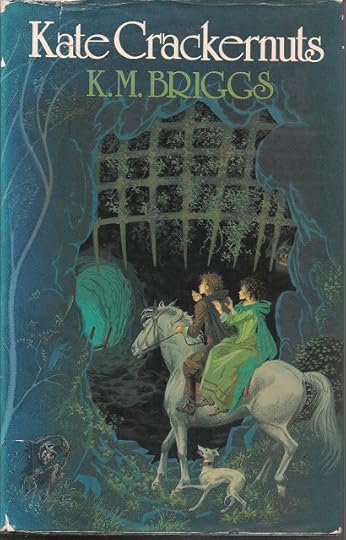
Katharine Briggs seems to have agreed, for she kept the two Kates in her lovely 1963 novel Kate Crackernuts in which she gives the fairy tale a local habitation and a date in 17th century Scotland at Auchenskeoch, Dumfries and Galloway, near the Solway Firth. And in her lightly rewritten version of the fairy tale in the 1976 Dictionary of Fairies, she calls the girls ‘the King’s Kate and the Queen’s Kate’, but follows Joseph Jacobs in making the all-night fairy dancing the cause of the prince’s illness. The Robertson/Lang version says nothing about this at all, but it makes good narrative sense.
Food is important in the story. Just a mouthful of bread or a handful of peas can protect the king’s Kate from her minnie’s (stepmother’s) wiles and the henwife’s spells. Bread was often blessed by having a cross cut into it, and perhaps the peas are given to her with a blessing, too? Then of course there are the nuts – probably hazel nuts – which Kate not only eats herself but uses as a medium of exchange for the fairy wand and bird. In Celtic legend the hazel is the tree of knowledge or divination, which may be why hazel rods are still used by water diviners. Hazel trees with crimson nuts were believed to grow around the pools at the source of Irish rivers. The nuts which fell into the water fed the Salmon of Knowledge, and anyone who ate the flesh of the salmon would in their turn become wise.
One sleepy afternoon two years ago I visited the deep, peaty pool at the source of the Shannon. The steep banks were sprinkled with flowers: gnats and mayflies rose and sank in the air, and although the trees leaning over it and dropping the occasional lazy leaf were willows, I could well imagine the Salmon of Knowledge swimming unseen in the brown water.
I wonder if Kate’s handful of hazel nuts brought her the wisdom and luck to succeed?

Once upon a time there was a king and a queen, as in many lands have been. The king had a daughter, Kate, and the queen had one too, but the king’s Kate was bonnier than the queen’s Kate, and the queen was jealous of her and cast about for a way to spoil her beauty. So she took counsel of the henwife, and the henwife told her to ‘send the lassie to me in the morn, fasting.’
So on the next morn, the queen sent the king’s Kate down to the henwife for eggs, but the lassie was hungry and snatched up a piece of bread before she went out. When she came to the henwife’s, she asked for the eggs as she’d been told to, and the henwife told her to ‘lift the lid of the pot there, and see.’ Well the lassie lifted the lid and up rose the steam, but nothing happened for all that. ‘Gae hame to your minnie, and tell her to keep her larder door better steekit,’ said the henwife. Then the queen knew that the lassie had had something to eat. Next morning she watched her, and sent her out fasting, but as the lassie went to the henwife’s she saw some country folk picking peas by the roadside, and spoke to them, and they gave her a handful of the peas which she ate by the way. So once again when she lifted the lid of the pot and the steam rose, no harm came to her, and the henwife said, ‘Tell your minnie the pot winna boil if there’s nae fire under it.’
On the third day, the queen takes the king’s Kate by the hand and herself leads her to the henwife. And now when the lassie lifts the lid of the pot and the steam rises, why, off jumps the princess’s ain bonnie head, and on jumps a sheep’s head!
Now the queen was quite satisfied and went home, but the queen’s ain daughter was angry. She took a fine linen cloth and wrapped it around her sister’s head, and took her by the hand and out they gaed to seek their fortune.
They gaed, and they gaed far, and further than I can tell, till they came to a king’s castle. Kate rapped on the door and asked for ‘a night’s lodging for my’sel and my sick sister.’
‘Aye, you shall have that,’ they said, ‘will ye but only sit up this night wi’ the king’s sick son and watch o’er him, and if a’s right wi’ him in the morning, ye shall have a peck o' siller as well.’
Aye, Kate was well willing to sit by him, and all went fine till midnight. Then the prince rose like one in a dream, and dressed himself, and with Kate stealing after him he went down to the stables, saddled his horse, called his hound and jumped into the saddle – and Kate jumped up behind. Away they rode through the greenwood and the hazel thickets, Kate picking nuts as they passed and filling her apron with them. They rode on and on till they came to a green hill. The prince drew rein and cried, ‘Open, open, green hill an’ let in the young prince with his horse and his hound,’ and Kate added, ‘and his lady him behind.’
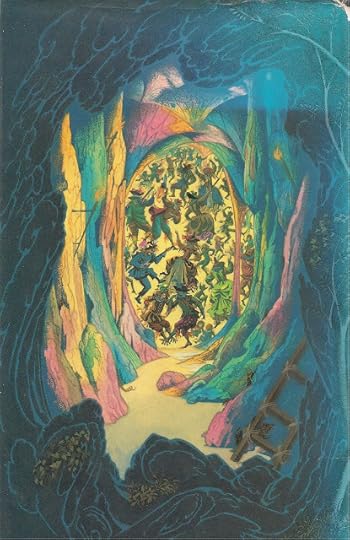
At once the green hill opened and in they passed to a great hall marvellously lit and full of dancers. Kate slipped off the horse and hid behind the door while a crowd of beautiful fairy women pulled the prince into the reel and made him dance and dance until he was faint with weariness, and at cock-crow he took his horse and rode home with Kate behind. Then he lay down in his bed and Kate sat by the fire and cracked her nuts and ate them. When the folk came in the morning, Kate told them the prince had slept well, so they said if she would another night with him, they would give her a peck of gold.
On the second night the prince rose as before and took his horse, and Kate rode with him to the fairy hill. Sitting behind the door as the prince danced, she saw a fairy bairn playing with a silver wand, and she overheard one of the dancers say, ‘Three straikes o’ that wand would make Kate’s sick sister as bonnie as ever she was.’ So Kate rolled nuts to the fairy boy, and she kept rolling them till the bairn dropped the wand to run after them, and Kate snatched it up and hid in in her gown and carried it with her when she rode back to the castle behind the prince. Then she tapped her sister three times with the wand, and off flew the sheep’s head and there she stood with her ain head on, bonnier than ever before, and when the brother to the sick prince saw her, he couldna take his eyes off her. And Kate sat down by the fire and cracked nuts and ate them.
So they asked Kate to sit with the prince for a third night, and she said she would only do it if she could marry him. And when he rose at midnight she followed him a third time into the fairy hill, and this time she saw the bairnie playing with a little dead bird, and heard one of the dancers saying, ‘Three bites of that birdie would make the sick prince as well as ever he was.’ Then Kate rolled nuts to the bairnie, and rolled and rolled them till he set down the birdie and ran after the nuts and Kate picked up the birdie and put it in her apron.
At cockcrow they set off home again, but this time instead of cracking nuts, Kate plucked the bird and roasted it at the fire, and at the smell of the roasting the prince said, ‘I wish I had a bite o’ that birdie,’ so Kate gave him a bit of the birdie, and he rose on his elbow. By and by he cried out again, ‘Oh, if I had another bite o’ that birdie!’, so Kate gave him another bit and he sat up on his bed. Then he said again, ‘Oh! If I had a third bite o’ that birdie!’ So Kate gave him a third bit, and he rose, dressed himself and sat down by the fire, quite well – and when the folk came in the morning, they found Kate and the young prince cracking nuts together.
So the sick son married the well sister, and the well son married the sick sister, and they all
Lived happy and they died happy,
And never drank out of a dry cappy.
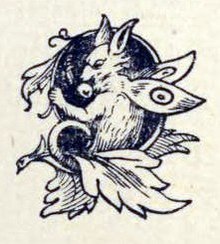
Picture credits:
'Off jumped her own pretty head': illustration by Morris Meredith Williams from The Scottish Fairy Book, 1910
'Kate Crackernuts': cover illustration by Pauline Baynes
'Kate Crackernuts': back cover illustration by Pauline Baynes
Published on August 27, 2020 01:48
August 18, 2020
Strong Fairy Tale Heroines #25: FAIR, BROWN AND TREMBLING
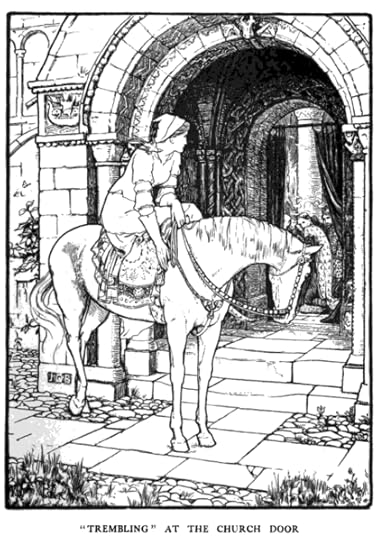
This Irish tale was collected by American folklorist Jeremiah Curtin who travelled through Kerry, Galway and Donegal in 1887 to transcribe and translate folk- and fairy tales from speakers of Erse. Curtin didn’t publish detailed notes on his sources, so the name of whoever told him the story is lost to history.
Fair, Brown and Trembling are princesses, daughters of the King of Tir Conal (Donegal in Ulster). We quickly forget their status though, since they live without servants in what seems to be no more than a small farmhouse. The tale falls into two halves: the first half is a Cinderella variant in which the two elder sisters make the youngest one, Trembling, do all the cooking and housework – and prevent her from attending church, which is the only social occasion available to them. But Trembling has a magical ally in the henwife – always a powerful figure in Irish tales – who sends her to church marvellously dressed and riding a succession of splendid mares. The second half of the story combines the various motifs of ‘the false bride’, ‘one sister pushes another into the water to drown’, and ‘being swallowed by a sea-monster’ – so there is plenty of action!
A thing I love about this story is that the Cinderella-figure, Trembling, gets to decide for herself the colour and style of the magically-produced fine clothes she wears to church. And she does this with delighted exuberance. After all, magic can do anything, so why not test the limits? Most fairy tale dresses are gold as the sun or silver as the moon and stars, but Trembling’s dresses put these into the shade – with no lack of specificity. First she asks for a white dress with green shoes, next for a dress of black satin with red shoes – and finally a dress of red and white with a green cape to wear over it, a multi-coloured feathered hat, and shoes with 'the toes red, the middle white, and the backs and heels green'. And that's before we even get to the horses. Such innocent flamboyance reminds me of my neighbour’s little girl, who was invited to choose a name for the family’s new kitten. After some thought she announced it would be called ‘Sparkling Rosy Crystal Pendant’ – and why not? (She was cross when her parents shortened it to Rosy.)
No wonder Trembling’s sisters (determined followers of fashion) can find no such dresses in all Erin. And if fashion can work such miracles, no wonder the son of the King of Omanya (Emain Macha) forgets his original attachment to the eldest sister, Fair, and transfers it to Trembling. Red and green are fairy colours, while black satin, splendid as it sounds, is not the usual garb for a simple maiden, so it’s hardly surprising when, dressed in magical clothes and riding on magical mares, all conjured up with the aid of a 'cloak of darkness', Trembling is strictly warned by the henwife not to go inside the church. (If she did, would the magical clothes vanish?) As the finishing touch, the henwife places ‘a honey-bird’ on Trembling’s right shoulder and a ‘honey-finger’ on her left. The story does not explain the significance of these, and I was left wondering what on earth a honey-finger could be? Some kind of sweetmeat?
Then I found a strikingly similar fairy tale which sheds light on it. ‘The Snow-White Maiden, and The Fair Maid, and The Swarthy Maid, and Frizzle or Bald-Pate Their Mother’ is a tale from Tiree in the Inner Hebrides which appeared in The Celtic Magazine, No. CLIV, August 1888, Vol XIII, contributed by the translator, Mrs Jessie Wallace, sister to the folklorist J G Campbell. (You will notice that although the heroines’ names are different, they both have one sister called ‘Fair’ and one called ‘Brown’; swarthy of course being simply another word that means ‘dark’.)
In this Hebridean tale the heroine’s magical helper is named in the Gaelic 'an Eachrais Urlair', which Wallace translates as ‘Trouble the House’ but glosses as ‘Cantrip’- a spell. 'Cantrip' places three twittering starlings on the girl’s right shoulder and three more on her left - a choice perhaps of magical significance. Starlings can be easily tamed and are great mimics; in the Second Branch of the Mabinogion it’s a starling which Branwen raises, teaches to speak, and sends from Ireland to Wales with a message to her brother Bendigeidfran which prompts war between the countries. The magical ‘Cantrip’ also grants to the Snow-White Maiden the gift that whenever she is thirsty all she has to do is put her hand to her mouth ‘and wine and honey will flow from your fingers’. The ‘honey-finger’ of the Irish tale must be a memory of this. The heroine's sister Fair Maid’s inability to refresh the prince with wine and honey in this way leads him to suspect her when, having pushed the Snow-White Maiden into a loch to be swallowed by a creature called the ‘Huge Senseless Beast’, she takes her place and pretends to be his wife. (Somehow it’s easier to accept the death of the Huge Senseless Beast than that of the whale in 'Fair, Brown and Trembling', but wincingly vivid as the details of its demise may be, we should regard this particular whale as simply another fairy tale monster.) Fair Maid lured her sister to the brink of the loch by calling her to look at their reflections and see how alike they are, which of course explains why she is able to deceive the prince at all. With nothing written down, details like these may often have been left out or forgotten by individual storytellers.
A distinctive feature of 'Fair, Brown and Trembling' is the combat between the princes to win Trembling’s hand in marriage. It doesn’t occur in most Cinderella variants, but oral story-telling is all about matching and mending and spinning a tale out to last a whole evening if necessary. I’ve left the passage in – but if I were telling it aloud I’d leave it out: it adds nothing of any real interest and distracts attention from the heroine, who is otherwise centre stage. Trembling directs events even after the whale has swallowed her, and her specific consent seems to be required for the marriage of her daughter to the little herd-boy. I have to add that the usually excellent John D Batten's illustrations for the story err on the tame side. Why show Trembling sitting passively on the horse, and lying in a heap on the beach, when he could have shown her galloping away from church and telling the herd-boy what to do? And - when you get to it - imagine the fun you could have, painting the third mare! It would be lovely to know of any illustrations which better express the colour and vigour of this tale.

King Aedh Cúracha lived in Tir Conal, and he had three daughters whose names were Fair, Brown, and Trembling.
Fair and Brown had new dresses, and went to church every Sunday. Trembling was kept at home to do the cooking and work. They would not let her go out of the house at all, for she was more beautiful than the other two, and they were in dread she might marry before themselves.
They carried on in this way for seven years. At the end of seven years the son of the king of Omanya fell in love with the eldest sister.
One Sunday morning, after the other two had gone to church, the old henwife came into the kitchen to Trembling and said, “It’s at church you ought to be this day, instead of working here at home.”
“How could I go?” said Trembling. “I have no clothes good enough to wear at church, and if my sisters were to see me there, they’d kill me for going out of the house.”
“I’ll give you,” said the henwife, “a finer dress than either of them has ever seen. And now be telling me what dress will you have?”
“I’ll have,” said Trembling, “a dress as white as snow, and green shoes to my feet.”
Then the henwife put on the cloak of darkness, clipped a piece from the old clothes the young woman had on, and asked for the whitest robes in the world and the most beautiful, and a pair of green shoes.
That moment she had the robe and the shoes, and she brought them to Trembling, who put them on. When Trembling was dressed and ready, the henwife said, “I have a honey-bird here to sit on your right shoulder, and a honey-finger to put on your left. At the door stands a milk-white mare, with a golden saddle for you to sit on, and a golden bridle to hold in your hand.”
Trembing sat on the golden saddle, and when she was ready to start, the henwife said, “You must not go inside the door of the church, and the minute the people rise up at the end of Mass, you must ride home as fast as the mare can carry you.”
When Trembling came to the door of the church there was no one inside who caught a glimpse of her but was striving to see who she was; and when they saw her hurrying away at the end of the Mass they ran out after her. But no use in their running: she was away before any man could come near her, and from the minute she left the church until she got home she overtook the wind before her and outstripped the wind behind.
She came down at the door, went in, and found the henwife had dinner ready. She put off the white robes and had her old dress on in a twinkling.
When the two sisters came home the henwife asked, “Have you any news today from the church?”
“We have, and great news,” they said. “We saw a grand, wonderful lady at the church door. We never saw the like of the robes she had on; it’s little was thought of our dresses beside what she was wearing, and there wasn’t a man at the church from the king to the beggar but was trying to look at her and see who she was.”
The sisters would give no peace till they had two dresses like the robes of the strange rich lady; but honey-birds and honey-fingers were not to be found.
Next Sunday the two sisters went to church again, and left the youngest at home to cook the dinner. After they had gone, the henwife came in and asked, “Will you go to church today?”
“I would go,” said Trembling, “if I could get the going.”
“What robe will you wear?” asked the henwife.
“The finest black satin that can be found, and red shoes to my feet.”
“What colour do you want the mare to be?”
“I want her to be so black and so glossy I can see myself in her body.”
The henwife put on the robes of darkness and asked for the robes and the mare. That moment, she had them. When Trembling was dressed, the henwife put the honey-bird on her right shoulder and the honey-finger on her left. The saddle on the mare was silver, and so was the bridle.
When Trembling sat in the saddle and was going away, the henwife ordered her strictly not to go inside the door of the church, but to rush away as soon as the people rose at the end of Mass, and hurry home on the mare before any man could stop her.
That Sunday the people were more astonished than ever, and gazed at her more than the first time; and all they were thinking of was to know who she was. But they had no chance, for the moment the people rose at the end of Mass she slipped from the church, was in the silver saddle, and home before a man could stop her or talk to her.
The henwife had the dinner ready. Trembling took off her satin robe, and had on her old clothes before her sisters got home.
“What news have you today?” asked the henwife of the sisters when they came from the church.
“Oh, we saw the grand, strange lady again! And it’s little that any man could think of our dresses after looking at the robes of satin she had on! And all at church, from high to low, had their mouths open, gazing at her, and no man was looking at us.”
The two sisters gave neither rest nor peace till they got dresses as nearly like the strange lady’s as could be found. Of course they were not so good; for the like of those robes could not be found in Erin.
When the third Sunday came, Fair and Brown went to church dressed in black satin. They left Trembling at home to work in the kitchen, and told her to be sure and have the dinner ready when they came back.
After they were out of sight, the henwife came to the kitchen and said, “Well my dear, are you for church today?”
“I would go if I had a new dress to wear.”
“What dress would you like?” asked the henwife.
“A dress red as a rose from the waist down, and white as snow from the waist up; a cape of green on my shoulders; and a hat on my head with a red, a white and a green feather in it; and shoes for my feet with the toes red, the middle white, and the backs and heels green.”
The henwife put on the cloak of darkness, wished for all these things and had them. When Trembling was dressed, the henwife put the honey-bird on her right shoulder and the honey-finger on her left, and placing the hat on her head, clipped a few hairs from one lock and a few from another with her scissors, and that moment the most beautiful golden hair was flowing down over the girl’s shoulders. Then the henwife asked what kind of a mare she would ride. She said white, with blue and gold-coloured diamond spots all over her body, on her back a saddle of gold, and on her head a golden bridle.
The mare stood there before the door, and a bird sitting between her ears, which began to sing as soon as Trembling was in the saddle, and never stopped till she came home from the church.
The fame of the beautiful strange lady had gone out through the world, and all the princes and great men that were in it came to church that Sunday, each one hoping that it was himself would have her home with him after Mass.
Now the son of the king of Omanya forgot all about the eldest sister whom he’d fallen in love with, and he remained outside the church so as to catch the strange lady before she could hurry away.
The church was more crowded than ever before, and there were three times as many outside. There was such a throng before the church that Trembling could only come inside the gate.
As soon as the people were rising at the end of Mass, the lady slipped out through the gate, was in the golden saddle in an instant, and sweeping away ahead of the wind. But if she was, the prince of Omanya was at her side, and seizing her by the foot he ran with the mare for thirty perches and never let go of the beautiful lady till the shoe was pulled from her foot, and he was left behind with it in his hand. She came home as fast as the mare could carry her, and was thinking all the time that the henwife would kill her for losing the shoe.
Seeing her so vexed and so changed in the face, the old woman asked: “What’s the trouble that’s on you now?”
“Oh! I’ve lost one of the shoes off my feet,” said Trembling.
“Don’t mind that, don’t be vexed,” said the henwife; “maybe it’s the best thing that ever happened to you.”
Then Trembling gave up all the things she had to the henwife, put on her old clothes and went to work in the kitchen. When the sisters came home, the henwife asked, “Have you any news from the church?”
“We have indeed,” said they, “for we saw the grandest sight today. The strange lady came again, in grander array than before. On herself and the horse she rode were the finest colours of the world, and between the ears of the horse was a bird which never stopped singing from the time she came till the she went away. The lady herself is the most beautiful woman ever seen by man in Erin.”
After Trembling had disappeared from the church, the son of the king of Omanya said to the other kings’ sons, “I will have that lady for my own.”
They all said, “You didn’t win her just by taking the shoe off her foot, you’ll have to win her by the point of the sword; you’ll have to fight for her with us before you can call her your own.”
“Well,” said the son of the king of Omanya, “when I find the lady that shoe will fit, I’ll fight for her, never fear, before I leave her to any of you.”
Then all the kings’ sons were uneasy, and anxious to know who was she that lost the shoe, and they began to travel all over Erin to know could they find her. The prince of Omanya and all the others went in a great company together, north, south, east and west: not a house in the kingdom did they leave out, to find the woman the shoe would fit, nor did they care whether she was rich or poor, of high or low degree.
The prince of Omanya always kept the shoe, and when the young women saw it they had great hopes, for it was of proper size, neither large nor small, though it would beat any man to know of what material it was made. One woman thought it would fit her if she cut a little from her great toe, and another, whose foot was too short, put something in the toe of her stocking. But no use, they only spoiled their feet, and were curing them for months afterwards.
The two sisters, Fair and Brown, heard that the princes of the world were looking all over Erin for the woman that could wear the shoe, and every day they were talking of trying it on, and one day Trembling spoke up and said, “Maybe it’s my foot that the shoe will fit.”
“Oh, the breaking of the dog’s foot on you! Why say so when you were at home every Sunday?”
So that way they went on waiting, and scolding the younger sister. The day the princes were to come, the sisters put Trembling in a closet and locked the door on her, and when the company came to the house, the prince of Omanya gave the shoe to the sisters. But though they tried and tried, it would fit neither of them.
“Is there any other young woman in the house?” asked the prince.
“There is!” said Trembling, speaking up in the closet. “I’m here.”
“Oh, we only have her here to put out the ashes,” said the sisters, but the prince and the others wouldn’t leave the house till they had seen her, so the two sisters had to open the door. When Trembling came out, the shoe was given to her, and it fitted exactly.
The prince of Omanya looked at her and said, “You are the woman the shoe fits, and you are the woman I took the shoe from.”
Then Trembling spoke up and said, “Do you stay here till I return.”
She went to the henwife’s house. The old woman put on the cloak of darkness, got everything for her she had the first Sunday at church, and put her on the white mare in the same fashion. Then Trembling rode along the highway to the front of the house, and all who saw her the first time said, “This is the lady we saw at church!”
Then she went away a second time, and a second time came back on the black mare, in the black dress the henwife gave her. All who saw her the second Sunday said, “That is the lady we saw at church.”
A third time she asked for a short absence, and soon came back on the third mare and in the third dress. All who saw her the third time said, “That is the lady we saw at church.” Everyone was satisfied and knew that she was the woman.
Then all the princes and great men spoke up. They said to the son of the king of Omanya, “You’ll have to fight now for her, before we let her go with you.”
“I’m here before you, ready for combat!”
So the son of the king of Lochlin stepped forth and a terrible struggle began. They fought for nine hours, and then the son of the king of Lochlin gave up the claim and left the field. Next day the son of the king of Spain fought six hours and yielded his claim. On the third day the son of the king of Nyerfói fought eight hours and stopped. The fourth day the son of the king of Greece fought six hours and stopped. On the fifth day no more strange princes wanted to fight, and all the sons of the kings in Erin said they would not fight with a man of their own land, that the strangers had had their chance, and as no others came to claim the woman, she belonged of right to the son of the king of Omanya.
The marriage day was fixed and the invitations were sent out. The wedding lasted for a year and a day. When the wedding was over, the king’s son brought home the bride, and when the time came, a son was born. Trembling sent for her eldest sister, Fair, to be with her and care for her. One day, when Trembling was well and her husband was away hunting, the two sisters went out to walk; and when they came to the seaside, the eldest pushed the youngest sister in. A great whale came and swallowed her.
The eldest sister came home alone, and the husband asked, “Where is your sister?”
“She has gone home to her father in Ballyshannon; now that I am well I don’t need her.”
“Well,” said the husband, looking at her, “I’m in dread it’s my wife that’s gone.”
“Oh no!” said she, “it’s my sister Fair that’s gone.”
Since the sisters were very much alike, the prince was in doubt. That night he put his sword between them and said, “If you are my wife, this sword will get warm; if not, it will stay cold.”
In the morning when he rose up, the sword was as cold as when he put it there.
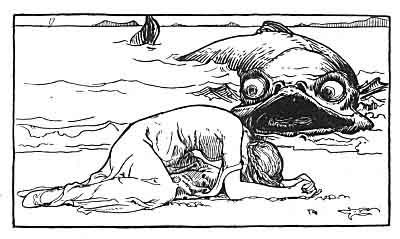
It happened that when the two sisters were walking by the seashore, a little boy was down by the water minding cattle, and he saw Fair push Trembling into the sea; and next day when the tide came in he saw the whale swim up and throw her out on the sand. When she was on the sand she said to the little boy, “When you go home in the evening with the cows, tell your master that my sister Fair pushed me into the sea yesterday, that a whale swallowed me and then threw me out, but will come again and swallow me with tomorrow’s tide and throw me out again on the strand. The whale will throw me out three times. I’m under the geas of this whale and cannot leave the beach or escape myself. Unless my husband saves me before I’m swallowed the fourth time, I shall be lost. He must come and shoot the whale with a silver bullet when he turns on the broad of his back. Under the breast-fin of the whale is a reddish-brown spot. My husband must hit him in that spot, for it is the only place in which he can be killed.”
When the little boy got home, the eldest sister gave him a draught of oblivion, and he did not tell.
Next day he went to the sea again. The whale came and cast Trembling up on the shore. She asked the boy, “Did you tell your master?”
“I did not,” said he. “I forgot.”
“How did you forget?” asked she.
“The woman of the house gave me a drink that made me forget.”
“Well don’t forget telling him this night, and if she gives you a drink, don’t take it from her.”
As soon as the boy came home, the eldest sister offered him a drink. He refused to take it till he had delivered his message and told all to the master. The third day he prince went down to the shore with his gun and a silver bullet in it. He was not long down when the whale came and threw Trembling upon the beach as the two days before. She had no power to speak to her husband till he had killed the whale. Then the whale went out, turned over one on the broad of his back and showed the spot for a moment only. That moment the prince fired. He had but the one chance, and a short one at that, but he took it and hit the spot, and the whale, mad with pain, made the sea all around red with blood and died.
That minute Trembling was able to speak, and went home with her husband, and as for the eldest sister, they had her put out to sea in a barrel, with provisions in it for seven years, to drift where the waves would bring her.
In time Trembling had a second child, a daughter. The prince and she sent the little herd boy to school and trained him up as one of their own children, and said, “If the little girl that is born to us now lives, no other man in the world will marry her but him.”
The herd boy and the prince’s daughter lived on till they were married. Trembling said to her husband, “You could not have saved me from the whale but for the little herd boy, and on that account I don’t grudge him my daughter.”
The son of the king of Omanya and Trembling had fourteen children, and they lived happily until the two of them died of old age.
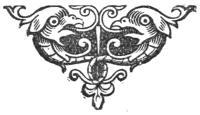
Published on August 18, 2020 02:04
August 11, 2020
Strong Fairy Tale Heroines #24: HE WHO LAUGHS AT OTHERS, OTHERS SHALL LAUGH AT HIM

What I love about this very satisfying Armenian fairy tale is that the heroine is an ugly old witch. Not a beautiful maiden - not even a maiden enchanted to seem old and ugly, like Sophie in Diana Wynne Jones’s ‘Howl’s Moving Castle’. No! She is what she is. And although she can use her magic to make herself seem young and pretty, she doesn’t want to. She knows her true self and has the strength and self-knowledge to prefer her real appearance to any illusion, and to ignore jeers and laughter. In the end, though, the continued mockery stings – and she decides to do something about it.
You may also enjoy the snappish exchange, around the mid-point of the story, between the Queen and the rather useless King.
The tale was told c. 1900 "by the illiterate labourer Manuk Avdalian in the village of Koph, province of Taron", collected by I. Orbeli and S. Taronian. It was translated into English and published as 'The Mocker Mocked' in ‘Armenian Folk-tales and Fables’ by Charles Downing, OUP 1972. The illustration is by William Papas.

I don’t know who and where and when exactly, but once upon a time there was a King of a land in the East who, when he had finished his work for the day, was in the habit of sitting at the window of his pavilion to watch the people passing by. One day he looked out and caught sight of the most weird and fantastical little old woman scurrying by under his window. So comical indeed was she that he burst into gales of loud laughter, almost strong enough to split his sides.
“Never have I seen such a ridiculously hideous old crone!” he declared. “She must be some sort of she-devil, one that haunts the bottom of a well!”
The poor old woman heard all this, but paid no attention to it and went on her way.
Well! One day, one week, one month later, when the King was again seated in his window, he caught sight of the old woman once more. As soon as he clapped eyes on her, up went the loud hoots and guffaws, and he laughed and laughed until the old woman finally lost patience. She came to a halt beneath his window.
“Laugh away, go on! Laugh!” she cried. “We’ll soon see which of the two of us laughs last!”
So saying, off she went.
Now don’t say a word to anyone, but between you and me this old woman was a sort of witch, able to take on any shape or form she wished. One day she might appear as a fine-grained angel, the next as some monstrous devil; she could turn the ugly into the beautiful and the fair into the repulsive; she could make the brainless clever and the intelligent stupid.
Well, that’s everything you need to know about the old woman, I don’t need to go on about it. Enough is enough. So this silly King just can’t give up his bad habit; the more he sees the old woman, the louder he laughs, until one day he goes too far and touches her to the quick. Unable to bear the ridicule any longer, she changes her shape and form, turns herself into a pretty young woman and goes to see the Queen.
“Your majesty,” she says, “I am as dust beneath your feet. My husband has died, leaving me with many little ones. Will you not hire me, as your maid, perhaps? I should come early in the morning, see to everything and go home in the evenings. That way I could earn enough to keep my children.”
“Well why not?” said the Queen. “You seem a pleasant, well-favoured body. You may bathe me and comb my hair. It’s my day of the week for a bath, so let us go now.”
They went to the bath-house, where the Queen had a good wash and then came out of the water. The witch took her comb and began to comb her hair – and no sooner did her hand touch her, than the Queen turned into a hideous old woman, so hideous indeed that the devil himself would have blanched to look at her! When the Queen saw herself in the mirror she had such a fright that she screamed out loud.
“King! King!” she yelled. “Come quickly!” And at the sound of her voice, the witch vanished.
The King ran up – looked – and saw that his wife’s nose had grown to an enormous length, her lips hung down to her bosom, her hair was as tangled as tree-roots, and as for her face, it was so grey you might have supposed someone had flung a shovelful of ashes over her.
“Wife, what has happened to you?” cried the King. And the Queen explained as best she could.
“A pretty young woman came along and begged me to employ her as a maid. When I had taken my bath, as soon as her hand touched me I was changed into the hideous monster you see. Do something!”
“What can I do, wife?” asked the King.
“Find that woman!” snapped the Queen.
Now the King was completely at a loss, not knowing which way to turn. Among a million women in the city, how could he find the one who had acted as the Queen’s maid? Ah well, to work! Let him get on with it, while we return to the witch.
As soon as the witch got home, she changed shape again and resumed her true, fantastical guise. Her conscience began to prick her, though, and in the end she got up and went to see the King. But when she arrived at the door of the pavilion, the guards wouldn’t let her in.
“Be off, you horrid old creature!” they cried. “The royal pavilion is no place for the likes of you!” And so saying, they thumped and shoved her, and shouted so loud that the noise of it reached the King.
He looked out. “What is it, my lads?” said he.
The guards pointed at the old woman, and stupid he may have been, but a glimmer of sense passed for once through the King’s head.
“Leave her alone!” he said. “Let her come in!”
He led her into the pavilion, sat on his throne and beckoned the old woman to stand before him. “What is your wish?” he asked.
“Your majesty,” said the witch, “I am the old woman you are always laughing at. Now do you see how your mockery has rebounded on your own head? If you want to know, I am the one who turned your wife into an ugly old woman. Are you still laughing?”
“Ah, woman!” said the King. “Now is a chance to make your fortune! Turn my wife back to what she was before, and I shall give you your weight in gold!”
The witch laughed.
“What are you laughing at?” said the King.
“What then? Why shouldn’t I laugh, now it is my turn?” mocked the witch. “Listen to me, King! When you laughed at me, I thought to myself that there could be no one more stupid in all the lands of the East. What you do to others shall fall on your own head. I am sorry for your wife, not you. Call her, and I shall turn her back into the pretty woman she was before. And from now on, perhaps a little good sense shall dwell in your head, and you will not be so ready to laugh at people in future!”
The witch reached out her hand, and the hideous Queen turned back into a beautiful lady. And before the King could say a word, the witch vanished. From that day forth, they say, the King never again made fun of the faults of others.
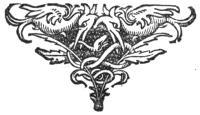
Published on August 11, 2020 03:40
August 4, 2020
'Star Daughter' - Guest Post by Shveta Thakrar

Pausing for a week my series on strong fairy tale heroines, I am delighted to welcome Shveta Thakrar to the blog. Her own words will introduce her better than I can, but having read and loved some of her short stories, I'm very much looking forward to her debut novel 'Star Daughter', which will be published in the USA on August 11th. (If like me you live in the UK, we have to wait until September 3rd.) Shveta weaves wonderful fairy tales and legends into her work, and as Holly Black has said of her writing, it’s “as beautiful as starlight”. I can't wait to meet her new heroine, Sheetal - who is bound to be another strong, inspiring and magical young woman.
When, in my mid-twenties, I committed to becoming a professional author, I decided to focus solely on desi characters and their adventures. I would write first and foremost for the girl I had been, I promised myself, the lonely, confused, self-doubting girl who’d needed the Hindu and Indian heritage she’d grown up with to be given equal footing with all the modern Western stories she and everyone around her were steeped in. That desire has never wavered; in fact, it’s only gotten stronger as I move forward in my career.
I have a whole catalog of published short stories and poems making good on this pledge, and now, as my debut young adult fantasy novel, Star Daughter, makes its way into the world, I’m thinking about the various flavors of mythology that appear in its pages. I’ve said elsewhere that it was pitched as Neil Gaiman’s and Charles Vess’s Stardust, an illustrated novel, meets Tanuja Desai Hidier’s Born Confused, a contemporary young adult novel, but the intersection of those two was really just the starting point.
Over the course of many drafts and almost as many years, I layered in references to stories from ancient texts such as the Mahabharata and the Bhagavad Purana, like the love story of Nala and Damayanti and the tale of Gajendra and the crocodile. I mentioned legendary characters from Hindu lore, like Urvashi the apsara and her erstwhile lover, mortal King Pururavas. Inspired by this vibrant source material, I even invented mythology of my own, like Sheetal’s mother’s tale of the origin of diamonds.
In my eyes, to craft fantasy narratives that draw on the mythology—or sacred stories—of my faith is to write a love letter to it. Fan fiction about and for the gods. You could argue that mythology itself is fan fiction in a sense, the first works celebrating notions and beings greater than we can otherwise conceptualize, always tweaking details as necessary (just look at how mythological “givens” shift from region to region and from era to era). Oral storytellers have always done this, embellishing and reworking their source material to meet their audience’s expectations and the messages they themselves wish to convey.
From that angle, when I weave these old stories into Star Daughter, I’m merely adding my voice to a long and complex lineage, the great chorus that has been singing since the beginning of human history. (An apt metaphor, as starsong flows from the beginning of the novel to the end.) No mythology is without dubious and sometimes even problematic aspects and contradictions, of course, but you can say the same thing about human progress; the stories we choose to tell and the way we tell them are a reflection of us. As we change, so do our stories and the lens through which we view them.
Mythology is not only mutable but timeless, too. No, you’re probably not going to wake up and find yourself an impossibly beautiful, mischievous, seductive apsara from the heavens—though with reincarnation, anything’s possible, right?—but who among us can’t understand pining after someone or something we can’t have? Pururavas and Urvashi undergo great trials for their love—including Urvashi being turned into a vine!—and while not all people seek out romantic relationships, I think it’s safe to say everyone yearns to love and be loved, whatever shape that takes.
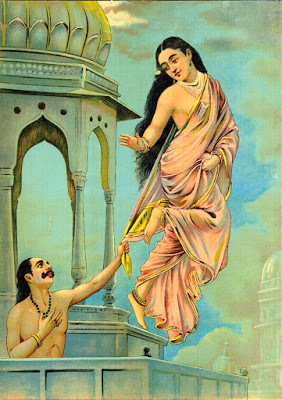 Pururavas and Urvashi Another fabled couple, Nala and Damayanti, is named in the novel as one of Sheetal’s favorites. The two of them, though husband and wife, are separated for years by jealous would-be suitors and forced to endure terrible hardships, but through their steadfast devotion, they eventually overcome all obstacles and find their way back to each other. It’s a story about never giving up, about having faith and acting from a pure heart despite the treachery and selfishness of others. Ultimately, we can only be responsible for our own actions—but we must be.
Pururavas and Urvashi Another fabled couple, Nala and Damayanti, is named in the novel as one of Sheetal’s favorites. The two of them, though husband and wife, are separated for years by jealous would-be suitors and forced to endure terrible hardships, but through their steadfast devotion, they eventually overcome all obstacles and find their way back to each other. It’s a story about never giving up, about having faith and acting from a pure heart despite the treachery and selfishness of others. Ultimately, we can only be responsible for our own actions—but we must be.Speaking of faith, the story of Gajendra the elephant has always stuck with me. One morning when he makes his daily pilgrimage to the lake where he picks lotuses as an offering for Lord Vishnu, a wily crocodile surfaces in the water and closes his powerful jaws on poor Gajendra’s leg. The two of them, predator and prey, are trapped in that stalemate for a thousand years, during which time Gajendra’s entire herd gives up and leaves him for dead. Finally, with his last breath, Gajendra calls upon Lord Vishnu for help while holding up the lotus he never released, and Lord Vishnu kills the crocodile, freeing Gajendra. If that’s not a lesson in having faith and trusting that help will arrive when one truly needs it, then I don’t know what is.
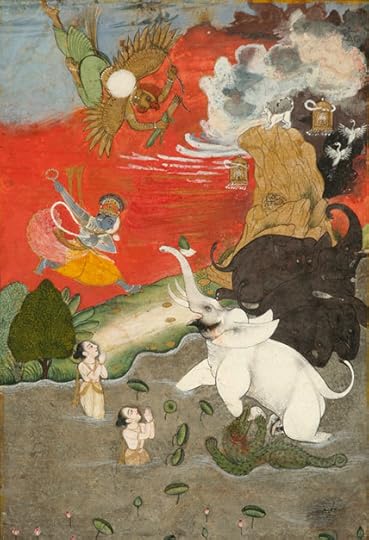 Gajendra is rescued by Vishnu Now that I’m thinking about it, each of these themes comes through in Star Daughter. That’s no surprise, really; the stories from my heritage are like a warm, fuzzy blanket I’ve taken comfort in since my childhood. They resonate in my bones and connect me to my ancestors, even if I never knew most of them, a garland of lotus blossoms leading from the distant past to now. I couldn’t imagine writing a fantasy and not incorporating them in some manner.
Gajendra is rescued by Vishnu Now that I’m thinking about it, each of these themes comes through in Star Daughter. That’s no surprise, really; the stories from my heritage are like a warm, fuzzy blanket I’ve taken comfort in since my childhood. They resonate in my bones and connect me to my ancestors, even if I never knew most of them, a garland of lotus blossoms leading from the distant past to now. I couldn’t imagine writing a fantasy and not incorporating them in some manner.And best of all, they’re fun. They’re fun to dust off and delight in and grumble at and reexamine and retell. To play with and use to create something new. After all, the power of a story rests squarely in the act of its being told, and so remembered. By giving these stories to Sheetal, I hope readers of my background will feel seen. For readers from different backgrounds, I invite them to explore these and other tales from the rich treasure trove of Hindu mythology.
From Sheetal and me, a blessing: may you, dear reader, burn bold in the deepest night.
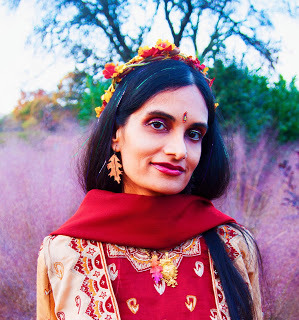 Shveta Thakrar Shveta Thakrar is a part-time
nagini
and full-time believer in magic. Her work has appeared in a number of magazines and anthologies including Enchanted Living, Uncanny Magazine, A Thousand Beginnings and Endings, and Toil & Trouble. Her debut young adult fantasy novel, Star Daughter, is out now from HarperTeen. When not spinning stories about spider silk and shadows, magic and marauders, and courageous girls illuminated by dancing rainbow flames, Shveta crafts, devours books, daydreams, travels, bakes, and occasionally even plays her harp.
Shveta Thakrar Shveta Thakrar is a part-time
nagini
and full-time believer in magic. Her work has appeared in a number of magazines and anthologies including Enchanted Living, Uncanny Magazine, A Thousand Beginnings and Endings, and Toil & Trouble. Her debut young adult fantasy novel, Star Daughter, is out now from HarperTeen. When not spinning stories about spider silk and shadows, magic and marauders, and courageous girls illuminated by dancing rainbow flames, Shveta crafts, devours books, daydreams, travels, bakes, and occasionally even plays her harp.Picture credits:
Pururavas and Urvashi by Raja Ravi Varma
Vishnu rescues Gajendra, India, mid-eighteenth century, Brooklyn Museum website
Shveta Thakrar, copyright
Published on August 04, 2020 00:52



